

Claude Monet’s six most splendid paintings of sailboats
by Barista Uno | Nov 15, 2021 | Maritime Art, Culture and History

Sailboats held as much as fascination for French Impressionist master Claude Monet as water lilies and haystacks . He made several paintings of them. The following, in my opinion, are his most splendid works on the subject. They spotlight not only the beauty and elegance of sailboats. More importantly, they show Monet’s inimitable handling of colour, light and atmosphere.
“For me, a landscape does not exist in its own right, since its appearance changes at every moment; but the surrounding atmosphere brings it to life – the air and the light, which vary continuously. For me, it is only the surrounding atmosphere which gives subjects their true value.”
— claude monet, 1891 (as quoted by tate uk ).

Sailboat in Petit-Gennevilliers, 1874 Claude Monet (1840–1926) Courtesy of Wikimedia Commons
A sky exploding with wonderful colours and reflections on the serene waters of the Seine combine to transform an ordinary sailboat into something majestic.

Sailboats, regatta at Argenteuil, 1874 Claude Monet (1840–1926) Courtesy of Wikimedia Commons
Monet used the same pale palette for the sky, the sailboats and the river, adding tints of red for the houses to break the uniformity. Sky and water are dappled, and the boats are appear bunched together as they move gracefully along the river. All this gives the painting a peculiar kind of vitality and charm.

Le Havre, Fishing Boats Leaving the Port, 1874 Claude Monet (1840–1926) Courtesy of Wikimedia Commons
It’s a wet morning, but a crowd has gathered on the waterfront to watch the fishing boats sail out of the harbour to the open sea. The small figures in the foreground make the boats and their proud sails seem like multistoried buildings. This is captivating art with a narrative element.

Fishing Boats at Sea, 1868 Claude Monet (1840–1926) Courtesy of Wikiart: Visual Art Encyclopedia
Monet turned an ordinary day in the life of fishermen into a theatrical scene. The boat in the foreground is like an actor making his stage entrance as the curtain of day is raised. The two boats are rendered in dark brown to provide a contrast to the streaks of white light in the sky.

The Cliffs at Étretat, 1886 Claude Monet (1840–1926) Courtesy of Wikiart: Visual Art Encyclopedia
This painting — one of many done by Monet of the Étretat cliffs — is bursting with energy. Small patches of green, yellow and brownish orange are skillfully blended to create the impression of a dynamic but not choppy sea. The brightly coloured sky and the flotilla of small fishing boats accentuate the massive, towering cliffs.

Seascape, Storm, 1866 Claude Monet (1840–1926) Courtesy of The Clark, Massachusetts, USA
Seascape, Storm is an early work by Monet that is markedly different in style and technique from his later Impressionist paintings. In lieu of small, swift brushtrokes, the colours are applied solidly with some areas worked with a palette knife. The fishing boat is set against an ominous grey sky, and the sea is mostly a dark green. Just below the horizon line is a long strip of bright green, Monet suggesting perhaps that the storm will blow over, that there is hope.
You may also like
Art vs. reality: claude monet’s paintings of étretat.

Did you like this article? Buy me a coffee
Let us know what you think of this article.
If you like this site buy me a coffee

Recent Posts
- A sonnet to mark 15 years of Marine Café Blog
- 5 things slowing down the campaign on seafarers’ rights
- Marine Café Blog is sailing again!
- ‘I am a feminist’: A male writer speaks up
- Sunsets at sea: Colour versus black & white photography
Don't Miss the Brew!
Sign up to be notified of updates to Marine Cafe Blog
You have Successfully Subscribed!
Pin it on pinterest.

Seascape Paintings by Claude Monet – 11 Maritime Masterpieces
Claude Monet, a pioneer of Impressionism, is renowned for his breathtaking seascape paintings that capture the essence of the sea in its various moods and atmospheres. With a masterful use of light, color, and brushstrokes, Monet’s seascapes transport viewers to coastal scenes filled with movement, tranquility, and dynamic beauty. From the shimmering reflections on water to the dramatic interplay of sky and sea, Monet’s seascapes are not just artistic renderings but immersive experiences that evoke a deep connection with nature’s ever-changing elements. In this article, we delve into some of Monet’s most famous seascape paintings, exploring their artistic techniques, themes, and enduring impact on the world of art.
Table of Contents
- 1 Monet and the Sea
- 2.1 The Seine Estuary at Honfleur (1865)
- 2.2 The Port of Sainte-Adresse (1867)
- 2.3 Garden at Sainte-Adresse (1867)
- 2.4 The Beach at Trouville (1870)
- 2.5 Impression, Sunrise (1872)
- 2.6 The Cliff Walk at Pourville (1882)
- 2.7 Boats on the Beach at Étretat (1883)
- 2.8 The Stormy Sea at Étretat (1883)
- 2.9 Fishing Boats at Étretat (1885)
- 2.10 Rocks at Belle-Île, Port-Domois (1886)
- 2.11 Morning on the Seine, near Giverny (1896)
- 3.1 What Inspired Claude Monet to Paint Seascape Paintings?
- 3.2 How Did Monet Capture the Essence of the Sea in His Paintings?
- 3.3 Which Seascape Painting by Monet Is Considered Iconic?
- 3.4 What Techniques Did Monet Use to Portray the Sea’s Shimmering Surface?
Monet and the Sea
Claude Monet, renowned for his mastery of capturing light and atmosphere, had a profound and evolving relationship with the sea in his artworks. Initially drawn to coastal scenes for their vibrant colors and dynamic play of light, Monet’s early seascapes depict the sea with a sense of awe and wonder. His paintings from the Normandy coast showcase his fascination with the ever-changing nature of the sea, from calm waters reflecting the sky to tumultuous waves crashing against the shore. As Monet’s career progressed, his approach to seascapes became more experimental.

He ventured to different coastal regions, including the rugged cliffs of Étretat and the picturesque harbors of Antibes and Venice. In these works, Monet explored the sea’s textures and the interplay between water, light, and atmosphere with increasing depth and nuance.
One of Monet’s most famous series, the Water Lilies paintings, also reflects his deep connection to water.
Although not depicting the sea directly, these monumental works capture the essence of water’s movement, tranquility, and reflective qualities, inviting viewers to immerse themselves in a contemplative experience akin to gazing at the sea’s vastness. Overall, Monet’s relationship with the sea in his artworks evolved from awe-inspired observations to a nuanced exploration of water’s visual and emotional richness, leaving an enduring legacy in the realm of seascape painting.
Top 11 Most Famous Seascape Paintings by Claude Monet
Discover the captivating allure of Monet’s top seascape works, where the artist’s mastery of light, color, and movement comes to life on canvas. Through Monet’s brushstrokes, the sea becomes a dynamic symphony of shimmering blues and greens, capturing the ever-changing essence of the ocean’s mood and atmosphere. Each painting invites you to immerse yourself in serene coastal scenes, where waves dance with sunlight and shores beckon with tranquil beauty.
Join us on a journey through Monet’s seascape masterpieces, where nature’s grandeur meets the artist’s vision in a breathtaking fusion of art and emotion.
The Seine Estuary at Honfleur (1865)
| 1865 | |
| Oil on canvas | |
| 89.5 x 150.5 | |
| The Norton Simon Museum, California, United States |
The Seine Estuary at Honfleur by Monet is a tranquil portrayal of the Honfleur coastline, where the sea takes on a dual role. On one hand, it serves as a reflective surface, mirroring the sky and enhancing the sense of depth in the painting. On the other hand, the sea symbolizes continuity and timelessness, connecting the land and the horizon in a seamless blend of earth and water.
Monet’s use of soft, natural tones in the sea creates a harmonious atmosphere, inviting viewers to contemplate the peaceful coexistence of natural elements.
The Port of Sainte-Adresse (1867)
| 1867 | |
| Oil on canvas | |
| 75 x 105 | |
| The Metropolitan Museum of Art, New York City, United States |
The Port of Sainte-Adresse captures Monet’s fascination with maritime life and coastal scenes. The sea here acts as a dynamic backdrop, showcasing the bustling activity of boats in the harbor. Its presence adds a sense of movement and energy to the composition, contrasting with the stillness of the boats and buildings in the foreground. Through his masterful use of light and color, Monet infuses the sea with a sense of life and vitality, reinforcing its role as a vital element in the coastal community.
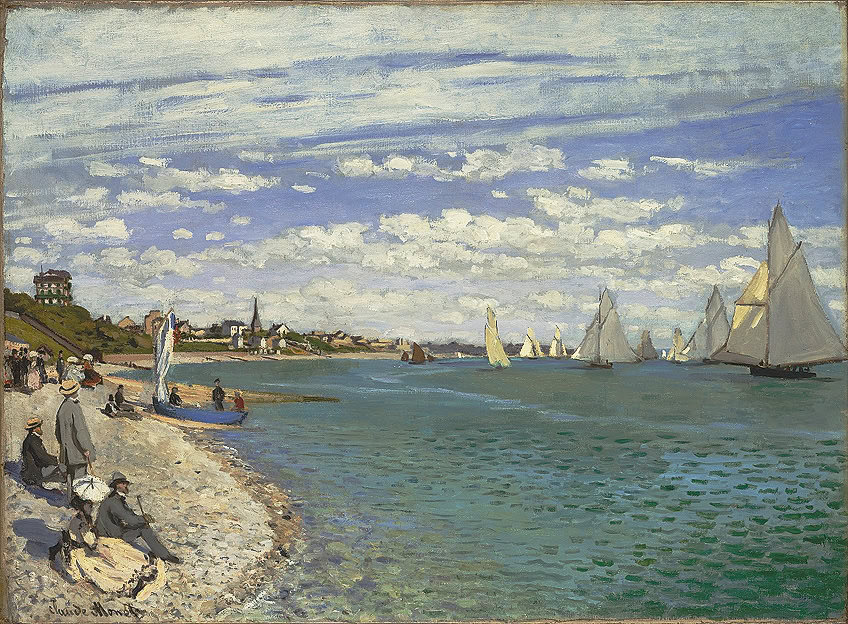
Garden at Sainte-Adresse (1867)
| 1867 | |
| Oil on canvas | |
| 98.1 x 129.9 | |
| The Metropolitan Museum of Art, New York City, United States |
In Garden at Sainte-Adresse , Monet combines the tranquility of a garden setting with the expansive beauty of the sea. Here, the sea serves as a visual anchor, stretching beyond the garden’s confines and merging with the distant horizon. Its presence lends a sense of vastness and freedom to the scene, enhancing the contrast between the intimate, enclosed space of the garden and the boundless expanse of the sea.
Monet’s careful attention to detail in capturing the play of light on water further emphasizes the sea’s importance as a natural force that shapes the environment.
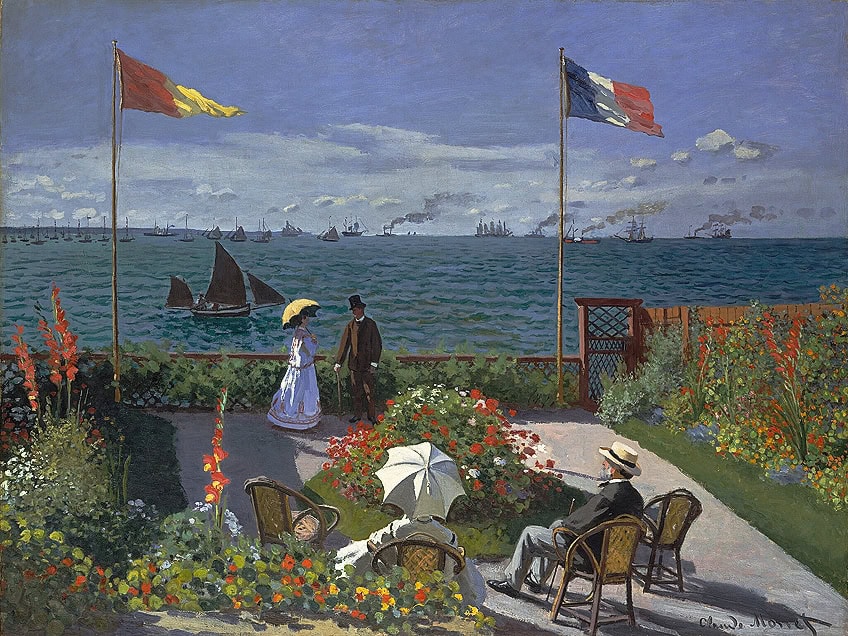
The Beach at Trouville (1870)
| 1870 | |
| Oil on canvas | |
| 38.7 x 46.5 | |
| The National Gallery, London, United Kingdom |
The Beach at Trouville portrays a lively coastal scene teeming with human activity against the backdrop of the sea. Here, the sea takes on a symbolic role, representing leisure, recreation, and the timeless appeal of seaside destinations. Monet’s depiction of waves gently lapping against the shore and distant sailboats evokes a sense of relaxation and enjoyment associated with beach outings. The sea becomes a central element in the narrative of leisure and pleasure, drawing viewers into the vibrant atmosphere of a coastal retreat.
Impression, Sunrise (1872)
| 1872 | |
| Oil on canvas | |
| 48 × 63 | |
| Musée Marmottan Monet, Paris, France |
Impression, Sunrise is a groundbreaking work that epitomizes Monet’s exploration of light, atmosphere, and the fleeting nature of perception. The sea in this painting serves as a canvas for the interplay of light and color, capturing the ephemeral qualities of dawn. As the sun rises over the horizon, casting a soft glow on the water, the sea becomes a metaphor for the passage of time and the transience of natural phenomena.
Monet’s bold brushwork and expressive use of color convey the sea’s ever-changing character, inviting viewers to contemplate the beauty of fleeting moments in nature.

The Cliff Walk at Pourville (1882)
| 1882 | |
| Oil on canvas | |
| 66.5 × 82.3 | |
| Art Institute of Chicago, Illinois, United States |
The Cliff Walk at Pourville encapsulates Monet’s fascination with capturing the interplay of light and movement in coastal settings. The sea in this painting serves as a dynamic element, contrasting the stability of the cliffs with its ever-changing waves. It symbolizes the eternal cycle of nature, where the sea’s constant motion shapes the landscape over time, creating a scene that is both tranquil and powerful.

Boats on the Beach at Étretat (1883)
| 1883 | |
| Oil on canvas | |
| 66 × 82.3 | |
| Art Institute of Chicago, Illinois, United States |
Boats on the Beach at Étretat presents a scene of quietude and reflection, where boats find respite in the calm waters near Étretat. The sea in this artwork embodies a sense of tranquility and stability, providing a peaceful backdrop for the resting boats.
Monet’s careful attention to detail in depicting the sea’s surface reflects his keen observation of light and its effects on water, enhancing the overall serenity of the composition.
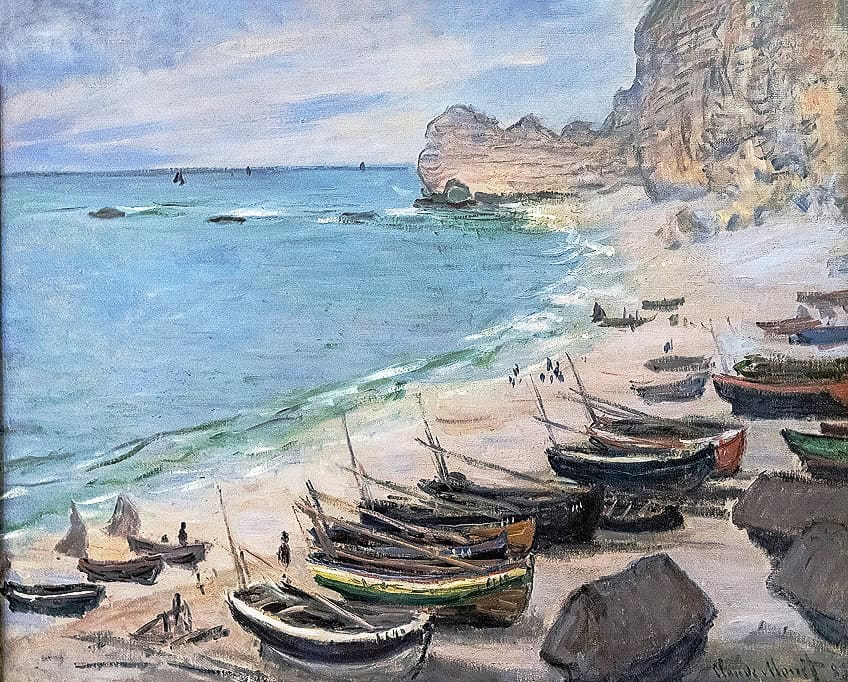
The Stormy Sea at Étretat (1883)
| 1883 | |
| Oil on canvas | |
| 60.3 × 81 | |
| The Museum of Fine Arts of Lyon, Lyon, France |
The Stormy Sea at Étretat captures the dramatic beauty of Étretat’s cliffs and the relentless energy of the sea. Here, the sea symbolizes both a force of nature and a source of inspiration for Monet. Its crashing waves against the rocky shore evoke a sense of power and grandeur, highlighting the rugged yet captivating character of coastal environments.
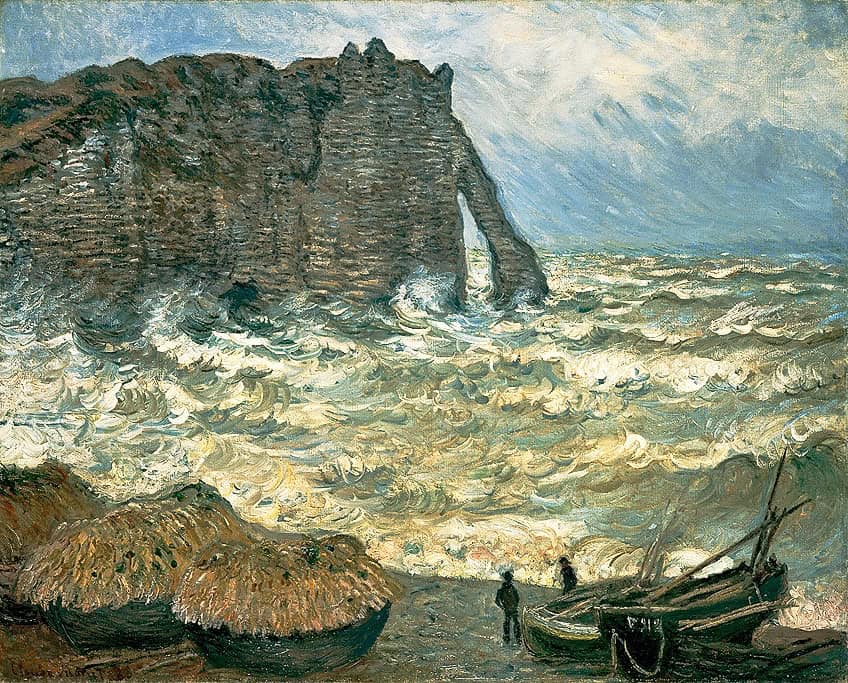
Fishing Boats at Étretat (1885)
| 1885 | |
| Oil on canvas | |
| 65 × 92 | |
| Seattle Art Museum, Washington State, United States |
Fishing Boats at Étretat immerses viewers in the bustling activity of a fishing community, where boats and fishermen coexist harmoniously with the sea. The sea in this painting represents a livelihood and a connection to the natural world, as fishermen depend on its bounty for sustenance. Monet’s skillful use of color and composition captures the vibrancy of daily life by the sea, inviting viewers to appreciate the symbiotic relationship between humans and the marine environment.
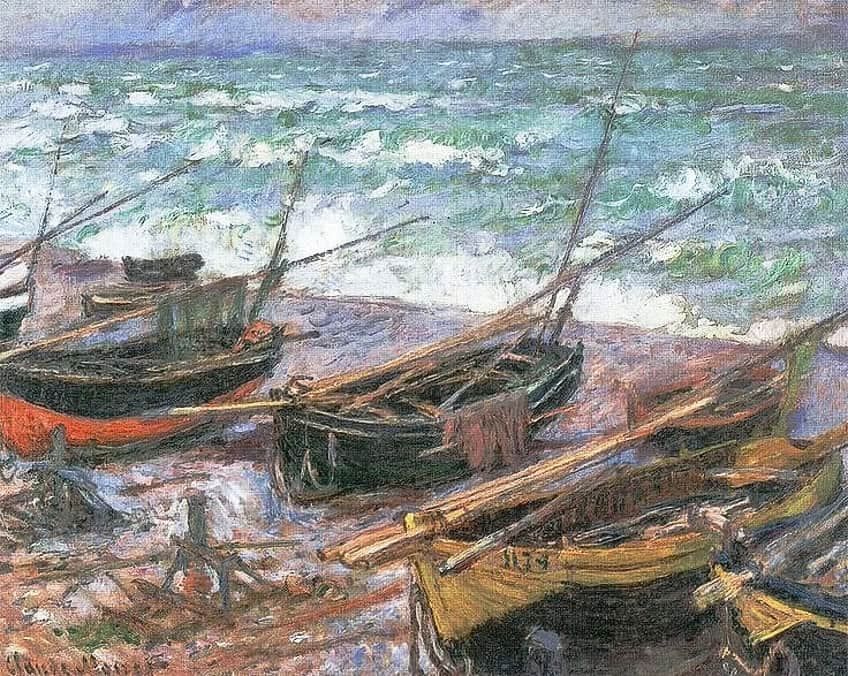
Rocks at Belle-Île, Port-Domois (1886)
| 1886 | |
| Oil on canvas | |
| 60 x 100 | |
| Musée d’Orsay, Paris, France |
Rocks at Belle-Île, Port-Domois showcases Monet’s ability to convey the rugged beauty of coastal formations. The sea in this artwork symbolizes resilience and endurance, as the rocky shoreline withstands the relentless forces of erosion.
Monet’s expressive brushwork and bold colors bring the rocky landscape to life, emphasizing the dynamic tension between solid rock and fluid water.

Morning on the Seine, near Giverny (1896)
| 1897 | |
| Oil on canvas | |
| 81.3 x 64.8 | |
| Museum of Fine Arts, Boston, United States |
Morning on the Seine, near Giverny shifts Monet’s focus to the tranquil waters of the Seine River, where the sea’s influence extends inland. The sea (represented by the river) here embodies a sense of calmness and continuity, as it flows steadily through the landscape. Monet’s mastery of atmospheric effects and subtle nuances of light captures the serene beauty of the river at daybreak, evoking a sense of harmony and introspection.
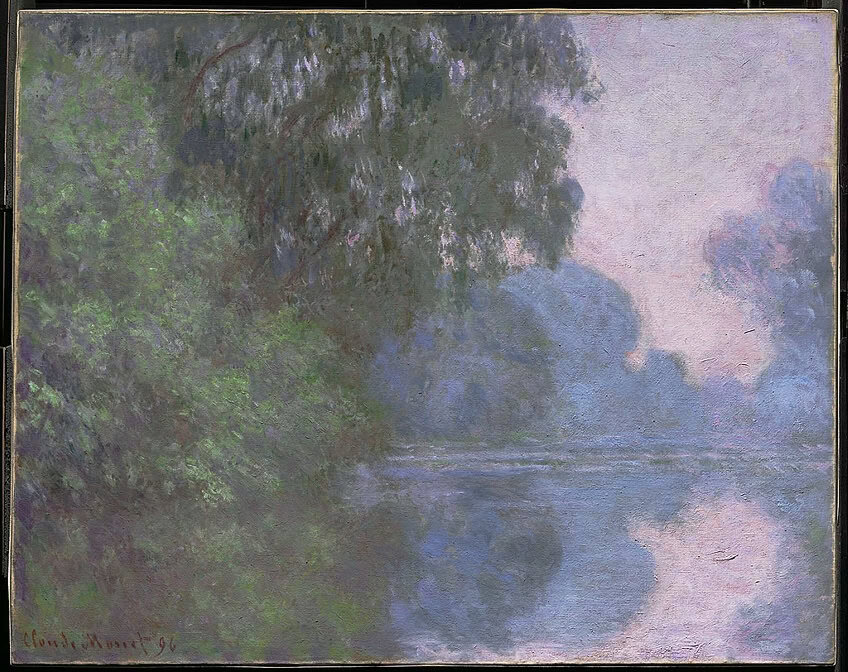
Monet’s famous seascape paintings capture the essence of the sea in its various moods and colors. Through his mastery of light, color, and brushwork, Monet brings to life the dynamic and ever-changing nature of the ocean. From the tranquil scenes of boats at rest to the powerful waves crashing against the shore, Monet’s seascapes not only showcase his technical skill but also evoke a sense of awe and admiration for the beauty of nature. His innovative use of color and light continues to inspire artists and art enthusiasts alike, making his seascape paintings timeless masterpieces in the world of art history.
Frequently Asked Questions
What inspired claude monet to paint seascape paintings.
Monet’s love for the sea was sparked during his visits to coastal regions like Normandy and Brittany. The ever-changing light, colors, and moods of the sea captivated his artistic sensibilities, leading to a lifelong exploration of seascape themes.
How Did Monet Capture the Essence of the Sea in His Paintings?
Monet’s innovative use of color and light allowed him to depict the sea’s dynamic nature. He often painted en plein air, directly observing and capturing the sea’s reflections, ripples, and atmospheric effects, creating a sense of movement and life in his works.
Which Seascape Painting by Monet Is Considered Iconic?
Impression, Sunrise (1872) is one of Monet’s most famous seascape paintings. It not only gave rise to the Impressionist movement but also exemplifies Monet’s mastery in depicting the sea’s mood through vibrant colors and loose brushstrokes.
What Techniques Did Monet Use to Portray the Sea’s Shimmering Surface?
Monet’s use of broken color and short brushstrokes, known as dabs, created an optical mixing effect that mimicked the sparkling and reflective nature of the sea’s surface. This technique, called Pointillism or Divisionism, added depth and luminosity to his seascape compositions.

Isabella studied at the University of Cape Town in South Africa and graduated with a Bachelor of Arts majoring in English Literature & Language and Psychology. Throughout her undergraduate years, she took Art History as an additional subject and absolutely loved it. Building on from her art history knowledge that began in high school, art has always been a particular area of fascination for her. From learning about artworks previously unknown to her, or sharpening her existing understanding of specific works, the ability to continue learning within this interesting sphere excites her greatly.
Her focal points of interest in art history encompass profiling specific artists and art movements, as it is these areas where she is able to really dig deep into the rich narrative of the art world. Additionally, she particularly enjoys exploring the different artistic styles of the 20 th century, as well as the important impact that female artists have had on the development of art history.
Learn more about Isabella Meyer and the Art in Context Team .
Cite this Article
Isabella, Meyer, “Seascape Paintings by Claude Monet – 11 Maritime Masterpieces.” Art in Context. May 22, 2024. URL: https://artincontext.org/seascape-paintings-by-claude-monet/
Meyer, I. (2024, 22 May). Seascape Paintings by Claude Monet – 11 Maritime Masterpieces. Art in Context. https://artincontext.org/seascape-paintings-by-claude-monet/
Meyer, Isabella. “Seascape Paintings by Claude Monet – 11 Maritime Masterpieces.” Art in Context , May 22, 2024. https://artincontext.org/seascape-paintings-by-claude-monet/ .
Similar Posts
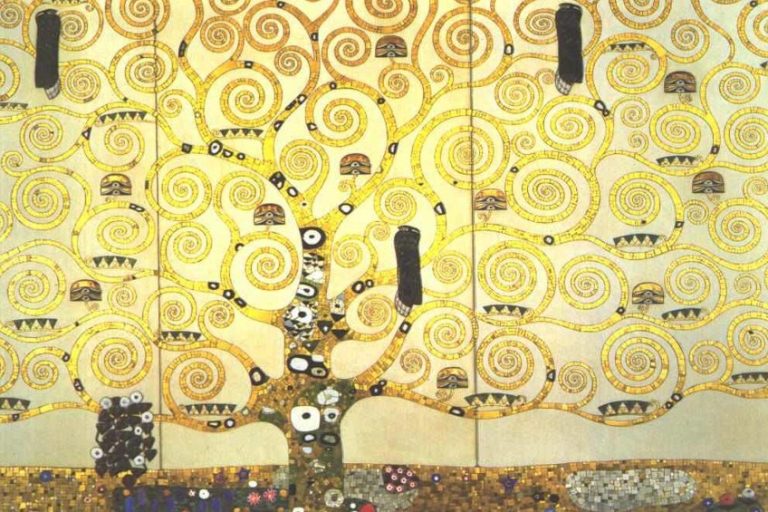
“Tree of Life” by Gustav Klimt – Looking at the Famous Stoclet Frieze
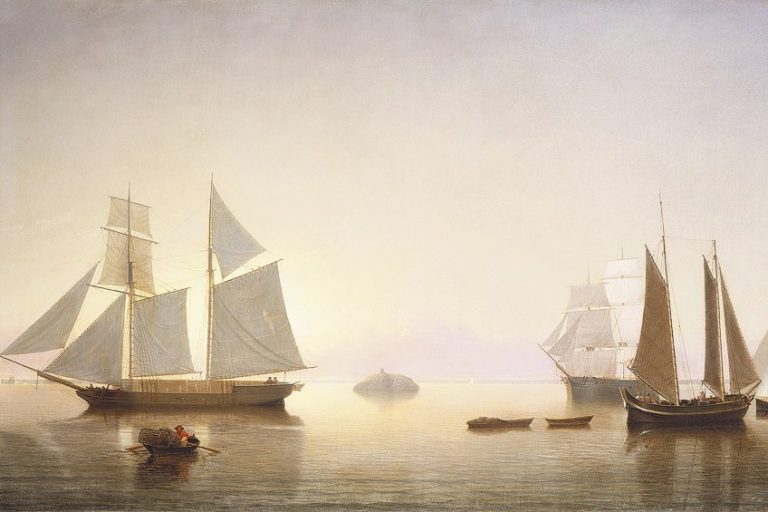
Famous Ship Paintings – Best Nautical Paintings of Ships at Sea

“The Creation of Adam” by Michelangelo – An In-Depth Analysis
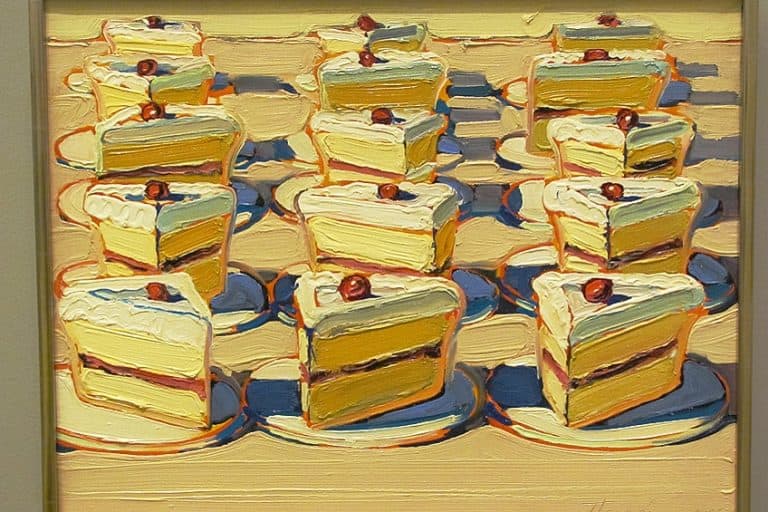
“Cakes” by Wayne Thiebaud – The Art of Dessert
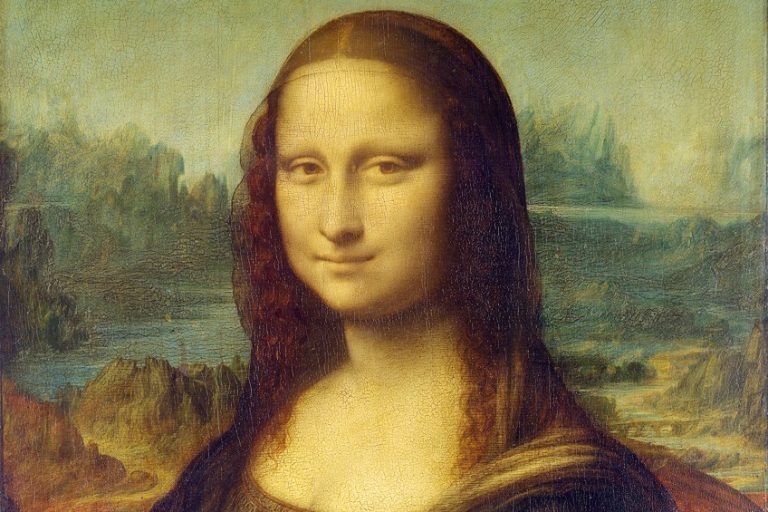
“Mona Lisa” by Leonardo da Vinci – Facts About the “Mona Lisa”

Kazimir Malevich “Black Square” – Analyzing the Famous Square Painting
Leave a reply cancel reply.
Your email address will not be published. Required fields are marked *
Save my name, email, and website in this browser for the next time I comment.
The Most Famous Artists and Artworks
Discover the most famous artists, paintings, sculptors…in all of history!

MOST FAMOUS ARTISTS AND ARTWORKS
Discover the most famous artists, paintings, sculptors!

Category : Paintings of boats by Claude Monet
Subcategories.
This category has the following 10 subcategories, out of 10 total.
- Bateaux sur la plage à Étretat (3 F)
- Boats Moored at Le Petit-Gennevilliers by Claude Monet (6 F)
- Fishing boats at Étretat (1885) (5 F)
- Garden at Sainte-Adresse by Claude Monet (6 F)
- Monet - Mer agitée à Etretat (6 F)
- Paintings of rowboats by Claude Monet (1 C, 41 F)
- Red Boats at Argenteuil (1875) by Claude Monet (7 F)
- The Beach at Sainte-Adresse by Claude Monet (3 F)
- The Green Wave by Claude Monet (5 F)
- The Railway Bridge at Argenteuil, Claude Monet, musée d'Orsay, 1874 (8 F)
Media in category "Paintings of boats by Claude Monet"
The following 200 files are in this category, out of 236 total.

- Paintings by Claude Monet by subject
- Impressionist paintings of boats
- Paintings of boats by artist
- 1870s paintings by Claude Monet
Navigation menu

See all hours
- Tue–Wed Closed
- Fri–Sun 11–5
- The first hour of every day, 10–11 a.m., is reserved for member-only viewing.
The Beach at Sainte-Adresse
Image actions.
- Show this image
Currently Off View
- Painting and Sculpture of Europe
Claude Monet (French, 1840–1926)
About this artwork
In the summer of 1867 Claude Monet stayed with his aunt in Sainte-Adresse, an affluent suburb of the port city of Le Havre in Normandy, where the artist grew up. Monet began the painting outdoors on an overcast day but likely revised the composition in his studio in view of other related canvases, especially the Metropolitan Museum of Art’s Regatta at Sainte-Adresse (51.30.4). Technical analysis revealed that what started as a scene of yachts and tourists at the beach ultimately became a view of sailboats and local fishermen. Monet first exhibited this painting at the Impressionist exhibition of 1876, the second of eight independent exhibitions he mounted with a group of like-minded avant-garde artists who sought to present their work outside of France’s traditional, state-sponsored Salon system.
Date Dates are not always precisely known, but the Art Institute strives to present this information as consistently and legibly as possible. Dates may be represented as a range that spans decades, centuries, dynasties, or periods and may include qualifiers such as c. (circa) or BCE.
Inscriptions, credit line, reference number, iiif manifest the international image interoperability framework (iiif) represents a set of open standards that enables rich access to digital media from libraries, archives, museums, and other cultural institutions around the world. learn more ., extended information about this artwork, publication history.
- Possibly “Notice of the Exhibition of the Society of French Artists, New Bond Street,” Times, Apr. 27, 1874. Reprinted in Kate Flint, ed., Impressionists in England: The Critical Reception (Routledge and Kegan Paul, 1984), p. 35.
- Possibly Durand-Ruel, London, Eighth Exhibition of the Society of French Artists, exh. cat. (Durand-Ruel, 1874), p. 11, cat. 142.
- Marius Chaumelin, “Actualités: L’exposition des intransigeants,” La gazette des étrangers, Apr. 8, 1876, pp. 1–2. Reprinted in Ruth Berson, ed., The New Painting: Impressionism, 1874–1886, Documentation, vol. 1,Reviews (Fine Arts Museums of San Francisco/University of Washington Press, 1996), p. 67.
- Catalogue de la 2e exposition de peinture [second Impressionist exhibition], exh. cat. (Alcan-Lévy, 1876), cat. 151.
- Emile Blémont, “Les impressionnistes,” Le rappel, Apr. 9, 1876, pp. 2–3. Reprinted in Ruth Berson, ed., The New Painting: Impressionism, 1874–1886, Documentation, vol. 1, Reviews (Fine Arts Museums of San Francisco/University of Washington Press, 1996), p. 63.
- Arthur Baignières, “Exposition de peinture par un groupe d’artistes, rue Le Peletier, II,” L’écho universel, Apr. 13, 1876, p. 3. Reprinted in Ruth Berson, ed., The New Painting: Impressionism, 1874–1886, Documentation, vol. 1, Reviews (Fine Arts Museums of San Francisco/University of Washington Press, 1996), p. 55.
- Pierre Dax, “Chronique,” L’artiste, May 1, 1876, p. 348. Reprinted in Ruth Berson, ed., The New Painting: Impressionism, 1874–1886, Documentation, vol. 1, Reviews (Fine Arts Museums of San Francisco/University of Washington Press, 1996), p. 70.
- Catalogue de la 2e exposition de peinture, exh. cat. (Alcan-Lévy, 1876), p. 15, cat. 151.
- Galerie Georges Petit, Claude Monet; A. Rodin, exh. cat. (Imp. de l’Art, 1889), p. 27, cat. 5. Reprinted in Theodore Reff, ed., Miscellaneous Group Exhibitions, Modern Art in Paris 34 (Garland, 1981), n.pag.
- Galerie Georges Petit, Paris, Collection H. V.: Catalogue de tableaux modernes de premier ordre, pastels, aquarelles, dessins, sale cat. (Galerie Georges Petit, Feb. 1–2, 1897), p. 109, lot 79.
- Gustave Geffroy, “Claude Monet,” L’art et les artistes 2, 11 (Nov. 1920), p. 64 (ill.).
- Gustave Geffroy, Claude Monet: Sa vie, son temps, son oeuvre (G. Crès, 1922), pp. opp. 40 (ill.), 59, 62, 71, 118, 262.
- Camille Mauclair, Claude Monet (F. Rieder, 1924), p. 36, pl. 6. Translated by J. Lewis May as Claude Monet (Dodd, Mead, 1924), p. 42, pl. 6.
- Xenia Lathom, Claude Monet (Philip Allan, 1931), p. 47, pl. 6.
- Eleanor Jewett, “Noted Private Art Collection on Exhibition,” Chicago Daily Tribune, Apr. 6, 1932, p. 19 (ill.).
- “Masterpieces of the French Impressionists from the Collection of Mrs. L. L. Coburn Being Exhibited for the First Time at the Art Institute of Chicago,” Fine Arts 19, 1 (June 1932), p. 22 (ill.).
- Daniel Catton Rich, “The Bequest of Mrs. L. L. Coburn,” Bulletin of the Art Institute of Chicago 26, 6 (Nov. 1932), pp. 66, 67 (ill.), 68.
- “Annie S. Coburn Estate Is Given $888,982 Value,” Chicago Daily Tribune, Nov. 19, 1932, p. 16.
- Art Institute of Chicago, Exhibition of the Mrs. L. L. Coburn Collection: Modern Paintings and Watercolors, exh. cat. (Art Institute of Chicago, 1932), pp. 18, no. 19; 47, no. 19.
- Daniel Catton Rich, “The Mrs. L. L. Coburn Collection,” in Art Institute of Chicago, Exhibition of the Mrs. L. L. Coburn Collection: Modern Paintings and Watercolors, exh. cat. (Art Institute of Chicago, 1932), p. 7.
- Art Institute of Chicago, Bulletin of the Art Institute of Chicago: Report for the Year Nineteen Hundred Thirty-Two 27, 3 (Mar. 1933), p. 24 (ill.).
- Art Institute of Chicago, Catalogue of “A Century of Progress”: Exhibition of Paintings and Sculpture; Lent from American Collections, ed. Daniel Catton Rich, 3rd ed., exh. cat. (Art Institute of Chicago, 1933), p. 43, cat. 292.
- Roger Brielle, “Le visage de la France vu par nos artistes: III. La Normandie,” L’art et les artistes 28, 143 (Jan. 1934), p. 129 (ill.).
- Art Institute of Chicago, Catalogue of “A Century of Progress”: Exhibition of Paintings and Sculpture, 1934, ed. Daniel Catton Rich, exh. cat. (Art Institute of Chicago, 1934), pp. 36–37, cat. 210.
- Toledo Museum of Art, Catalogue: French Impressionists and Post-Impressionists, exh. cat. (Toledo Museum of Art, 1934), n.pag., cat. 8 (paintings).
- Art Institute of Chicago, A Brief Illustrated Guide to the Collections (Art Institute of Chicago, 1935), p. 28.
- William Rockhill Nelson Gallery of Art and Mary Atkins Museum of Fine Arts, “Exhibition of French Impressionist Landscape Paintings,” William Rockhill Nelson Gallery of Art and Atkins Museum of Fine Arts News Flashes 3, 2 (Dec. 1, 1936), p. 2.
- William Rockhill Nelson Gallery of Art and Mary Atkins Museum, Exhibition: French Impressionist Landscape Painting, exh. cat. (William Rockhill Nelson Gallery of Art and Mary Atkins Museum, 1936), cover (ill.); p. 6, cat. 23.
- Lionello Venturi, Les archives de l’impressionnisme: Lettres de Renoir, Monet, Pissarro, Sisley et autres; Mémoires de Paul Durand-Ruel; Documents, vol. 2 (Durand-Ruel, 1939), p. 257.
- Art Institute of Chicago, “List of Exhibitions,” Bulletin of the Art Institute of Chicago 39, 4 (Apr.–May 1945), p. 64.
- John Rewald, The History of Impressionism (Museum of Modern Art/Simon & Schuster, 1946), p. 137 (ill.).
- Art Institute of Chicago, An Illustrated Guide to the Collections of the Art Institute of Chicago (Art Institute of Chicago, 1948), p. 34.
- Oscar Reuterswärd, Monet: En konstnärshistorik (Bonniers, 1948), p. 281.
- Art Institute of Chicago, “Notes,” Bulletin of the Art Institute of Chicago 34, 1 (Feb. 1949), p. 15.
- Kenneth Clark, Landscape into Art (John Murray, 1949), pp. xiii; 88, pl. 81.
- Daniel Catton Rich, “Midwest Art Capital,” Town and Country 105 (Mar. 1951), p. 75 (ill.).
- Kunsthaus Zürich, Claude Monet: 1840–1926, with a foreword by Georges Besson and René Wehrli, exh. cat. (Kunsthaus Zürich, 1952), pl. 4; p. 19, cat. 11.
- Haags Gemeentemuseum, Claude Monet, with an introduction by George Besson, exh. cat. (Gemeentemuseum, 1952), cat. 9 (ill.).
- Meyer Schapiro, Paul Cezanne (Abrams, 1952), pp. 11 (ill.), 12.
- Daniel Wildenstein, Claude Monet, exh. cat. (Galerie Beaux-Arts, 1952), pp. 14, cat. 8 (ill.); 59.
- Art Institute of Chicago, An Illustrated Guide to the Collections of the Art Institute of Chicago (Art Institute of Chicago, 1956), p. 34.
- Art Institute of Chicago, “Homage to Claude Monet,” Art Institute of Chicago Quarterly 51, 2 (Apr. 1, 1957), pp. 22 (ill.), 24.
- Art Institute of Chicago, “Chronology,” Art Institute of Chicago Quarterly 51, 2 (Apr. 1, 1957), p. 28.
- Art Institute of Chicago, “Catalogue,” Art Institute of Chicago Quarterly 51, 2 (Apr. 1, 1957), p. 33
- Art Institute of Chicago, “Exhibitions,” Art Institute of Chicago Quarterly 51, 2 (Apr. 1, 1957), p. 36.
- Claude Monet: A Loan Exhibition, exh. cat. (Minneapolis Society of the Fine Arts, 1957), p. 45, cat. 4 (ill.).
- William C. Seitz, “Claude Monet’s View of Nature,” in Claude Monet: A Loan Exhibition, exh. cat. (Minneapolis Society of the Fine Arts, 1957), pp. 16, 21, 24.
- Denis Rouart, Claude Monet, trans. James Emmons (Skira, 1958), p. 38 (ill.).
- William C. Seitz, Claude Monet (Abrams, 1960), pp. 74, 75 (ill.).
- Arthur Millier, “Summer Relief: ‘Painters by the Sea,’” Los Angeles Times, Aug. 27, 1961, p. N18 (ill.).
- Art Institute of Chicago, Paintings in the Art Institute of Chicago: A Catalogue of the Picture Collection (Art Institute of Chicago, 1961), pp. 278 (ill.), 318.
- Frederick A. Sweet, “Great Chicago Collectors,” Apollo 84, 55 (Sept. 1966), pp. 201, fig. 32; 202–03.
- Joel Isaacson, “The Early Paintings of Claude Monet” (Ph.D. diss., University of California, Berkeley, 1967), pp. xii, 183–84, 185.
- Edward Barry, “The Institute That Art Built,” Chicago Tribune, Mar. 2, 1969, p. 84.
- Charles C. Cunningham and Satoshi Takahashi, Shikago Bijutsukan [Art Institute of Chicago], Museums of the World 32 (Kodansha, 1970), p. 55, cat. 41 (ill.); 160–61.
- John Maxon, The Art Institute of Chicago (Abrams, 1970), pp. 80 (ill.), 81.
- Anthea Callen, “Jean-Baptiste Faure, 1830–1914: A Study of a Patron and Collector of the Impressionists and Their Contemporaries with a Catalogue of His Collection” (M.A. thesis, University of Leicester, 1971), pp. 28; 325–26, cat. 437.
- Gerald Needham, “The Paintings of Claude Monet, 1859–1878” (Ph.D. diss., Institute of Fine Arts, New York University, 1971), pp. 88–89; 154–57; fig. 42.
- Denis Rouart, “Apparences et reflets,” in Denis Rouart and Jean-Dominique Rey, Monet, nymphéas, ou Les miroirs du temps, with a cat. rais. by Robert Maillard (Hazan, 1972), p. 40.
- Kermit Swiler Champa, Studies in Early Impressionism (Yale University Press, 1973), pp. 19; 20, fig. 26.
- Daniel Wildenstein, Claude Monet: Biographie et catalogue raisonné, vol. 1, Peintures, 1840–1881 (Bibliothèque des Arts, 1974), pp. 38; 162; 163, cat. 92 (ill.).
- M. Therese Southgate, “About the Cover,” JAMA: The Journal of the American Medical Association 232, 4 (Apr. 28, 1975), cover (ill.); p. 340 (ill.).
- M. Therese Southgate, “About the Cover,” JAMA: The Journal of the American Medical Association 233, 3 (July 21, 1975), p. 259.
- Horst Keller, Die Kunst der französischen Impressionisten (Herder, 1975), pp. 54; 128–29, pl. 80; 269.
- Mike Samuels and Nancy Samuels, Seeing with the Mind’s Eye: The History, Techniques, and Uses of Visualization (Random House, 1975), p. 70 (ill.).
- Grace Seiberling, “The Evolution of an Impressionist,” in Paintings by Monet, ed. Susan Wise, exh. cat. (Art Institute of Chicago, 1975), p. 30.
- Susan Wise, ed., Paintings by Monet, exh. cat. (Art Institute of Chicago, 1975), p. 64, cat. 10 (ill.).
- Charles C. Cunningham, Susan D. Peters, and Kathleen Zimmerer, Jongkind and the Pre-Impressionists: Painters of the Ecole Saint-Siméon, exh. cat. (Sterling and Francine Clark Art Institute, 1977), pp. 23; 134, cat. 90 (ill.); 135.
- Art Institute of Chicago, 100 Masterpieces (Art Institute of Chicago, 1978), pp. 22; 90–91, fig. 48.
- Luigina Rossi Bortolatto, L’opera completa di Claude Monet, 1870–1889, Classici dell’arte 63 (Rizzoli, 1972), pp. 89, cat. 19 (ill.); 90.
- Roger Terry Dunn, “The Monet-Rodin Exhibition at the Galerie Georges Petit in 1889” (Ph.D. diss., Northwestern University, 1978), pp. 78, 246.
- Gaëtan Picon, The Birth of Modern Painting (Skira, 1978), pp. 62–63 (ill.), 118.
- J. Patrice Marandel, The Art Institute of Chicago: Favorite Impressionist Paintings (Crown, 1979), pp. 52–53 (ill.).
- J. Patrice Marandel, “New Installation of Earlier Paintings,” Bulletin of the Art Institute of Chicago 73, 1 (Jan.–Feb. 1979), p. 15 (ill.).
- Brian Petrie, Claude Monet: The First of the Impressionists (Phaidon, 1979), pp. 31–32, pl. 26; 33.
- Hélène Adhémar, Anne Distel, and Sylvie Gache, Hommage à Claude Monet (1840–1926), exh. cat. (Réunion des Musées Nationaux, 1980), pp. 80; 82, cat. 16 bis (ill.).
- Diane Kelder, The Great Book of French Impressionism (Abbeville, 1980), pp. 182 (ill.), 437.
- Musée Toulouse-Lautrec and Art Institute of Chicago, Trésors impressionnistes du Musée de Chicago, exh. cat. (Musée Toulouse-Lautrec, 1980), pp. 31, no. 9 (ill.); 67.
- Andrea P. A. Belloli, ed., A Day in the Country: Impressionism and the French Landscape, exh. cat. (Los Angeles County Museum of Art, 1984), p. 364.
- Sylvie Gache-Patin, “Private and Public Gardens,” in A Day in the Country: Impressionism and the French Landscape, ed. Andrea P. A. Belloli, exh. cat. (Los Angeles County Museum of Art, 1984), p. 217.
- Sylvie Gache-Patin and Scott Schaefer, “Impressionism and the Sea,” in A Day in the Country: Impressionism and the French Landscape, ed. Andrea P. A. Belloli, exh. cat. (Los Angeles County Museum of Art, 1984), p. 276.
- Scott Schaefer, “The French Landscape Sensibility,” in A Day in the Country: Impressionism and the French Landscape, ed. Andrea P. A. Belloli, exh. cat. (Los Angeles County Museum of Art, 1984), pp. 58; 62; 66; 69, no. 6 (ill.).
- Scott Schaefer, “L’évasion loin de Paris,” in Réunion des Musées Nationaux, L’impressionnisme et le paysage français, exh. cat. (Réunion des Musées Nationaux, 1985), p. 342.
- Scott Schaefer, “The Retreat from Paris,” in A Day in the Country: Impressionism and the French Landscape, ed. Andrea P. A. Belloli, exh. cat. (Los Angeles County Museum of Art, 1984), p. 312.
- Sylvie Gache-Patin, “Jardins privés et jardins publics,” in Réunion des Musées Nationaux, L’impressionnisme et le paysage français, exh. cat. (Réunion des Musées Nationaux, 1985), p. 222.
- Sylvie Gache-Patin and Scott Schaefer, “La mer,” in Réunion des Musées Nationaux, L’impressionnisme et le paysage français, exh. cat. (Réunion des Musées Nationaux, 1985), p. 295.
- Scott Schaefer, “Le paysage dans la peinture française au cours des années 1860,” in Réunion des Musées Nationaux, L’impressionnisme et le paysage français, exh. cat. (Réunion des Musées Nationaux, 1985), pp. 46; 48; 54–55, no. 6 (ill.).
- Richard Shiff, Cézanne and the End of Impressionism: A Study of the Theory, Technique, and Critical Evaluation of Modern Art (University of Chicago Press, 1984), pp. 108; 110–11, fig. 21; 116.
- John House, “Monet and the Genesis of His Series,” in Auckland City Art Gallery, Claude Monet: Painter of Light, exh. cat. (Auckland City Art Gallery/NZI, 1985), pp. 12; 13, fig. 3.
- Hollis Clayson, “A Failed Attempt,” in The New Painting: Impressionism, 1874–1886, ed. Charles S. Moffett, exh. cat. (Fine Arts Museums of San Francisco, 1986), p. 147.
- Charles S. Moffett, ed., The New Painting: Impressionism, 1874–1886, exh. cat. (Fine Arts Museums of San Francisco, 1986), pp. 162; 163; 180, cat. 31 (ill.).
- Richard R. Brettell, French Impressionists (Art Institute of Chicago/Abrams, 1987), pp. 10 (detail), 11, 12 (ill.), 118.
- Douglas Skeggs, River of Light: Monet’s Impressions of the Seine (Victor Gollancz, 1987), pp. 37, 39 (ill.).
- Robert L. Herbert, Impressionism: Art, Leisure, and Parisian Society (Yale University Press, 1988), pp. 264–65, pl. 267 (detail); 265; 284; 289, pl. 295; 290; 292; 296.
- Ministry of Culture; State Hermitage Museum; Pushkin State Museum of Fine Arts; Metropolitan Museum of Art, New York; and Art Institute of Chicago, Ot Delakrua do Matissa: Shedevry frantsuzskoi zhivopisi XIX–nachala XX veka, iz Muzeia Metropoliten v N’iu-Iorke i Khudozhestvennogo Instituta v Chikago [From Delacroix to Matisse: Masterpieces of French Painting of the Nineteenth to the Beginning of the Twentieth Century from the Metropolitan Museum of Art, New York, and the Art Institute of Chicago], trans. from English by Iu. A. Kleiner and A. A. Zhukov, exh. cat. (Avrora, 1988), pp. 76–77, cat. 27 (ill.).
- Francesco Arcangeli, Monet (Nuova Alfa, 1989), pp. 29–30; 82, fig. 8.
- Michael Howard, Monet (Brompton, 1989), p. 50 (ill.).
- Richard Kendall, ed., Monet by Himself: Paintings, Drawings, Pastels, Letters, trans. Bridget Strevens Romer (Macdonald Orbis, 1989), pp. 43 (ill.), 317.
- Musée Rodin, Claude Monet; Auguste Rodin: Centenaire de l’exposition de 1889, exh. cat. (Musée Rodin, 1989), pp. 53, 74 (ill.).
- Jacques Vilain, “Les débuts (1840–1870),” in Musée Rodin, Claude Monet; Auguste Rodin: Centenaire de l’exposition de 1889, exh. cat. (Musée Rodin, 1989), p. 111.
- Alvin Martin and Judi Freeman, “The Distant Cousins in Normandy: Braque, Dufy, and Friesz,” in Judi Freeman, The Fauve Landscape, exh. cat. (Los Angeles County Museum of Art/Abbeville, 1990), p. 226, pl. 237.
- Denis Rouart, Monet (Nathan, 1990), p. 23 (ill.).
- Karin Sagner-Düchting, Claude Monet, 1840–1926: Ein Fest für die Augen (Benedikt Taschen, 1990), pp. 36–37 (ill.), 38. Translated by Karen Williams as Claude Monet, 1840–1926: A Feast for the Eyes (Taschen, 2004), pp. 36–37 (ill.), 38.
- John Russell Taylor, Impressionist Dreams: The Artists and the World They Painted (Barrie & Jenkins, 1990), p. 59 (ill.).
- Stanley David Gedzelman, “Weather Forecasts in Art,” Leonardo 24, 4 (1991), pp. 446; 447, fig. 6.
- Stanley David Gedzelman, “The Sky in Art,” Weatherwise 44, 6 (Dec. 1991/Jan. 1992), pp. 10 (ill), 11, 12.
- Norma Broude, Impressionism: A Feminist Reading (Rizzoli, 1991), pp. 24; 93, pl. 13.
- Charles S. Moffett, “Sainte-Adresse,” in National Gallery of Art, Art for the Nation: Gifts in Honor of the 50th Anniversary of the National Gallery of Art, exh. cat. (National Gallery of Art, Washington, D.C., 1991), p. 154.
- Hermann Bauer, Hubert Burda, and Christa Maar, eds., “Impressionismus: Spurensuche für die Jahrhundertwende,” special issue, Pan 1 (1992), p. 4 (ill.).
- Sophie Fourny-Dargère, Monet, Profils de l’art (Chêne, 1992), pp. 148, fig. 13; 156.
- Sylvie Patin, Monet: “Un oeil … mais, bon Dieu, quel oeil!” (Gallimard/Réunion des Musées Nationaux, 1991), pp. 12–13 (detail). Translated by Anthony Roberts as Monet: The Ultimate Impressionist (Abrams, 1993), pp. 12–13 (detail).
- Daniel Wildenstein, Claude Monet: Catalogue raisonné, vol. 5, Supplément aux peintures: Dessins; Pastels; Index (Wildenstein Institute, 1991), p. 23, cat. 92.
- Virginia Spate, Claude Monet: Life and Work (Rizzoli, 1992), pp. 46–47, ill. 43, 48, 115, 117, 154.
- Art Institute of Chicago, Treasures of 19th- and 20th-Century Painting: The Art Institute of Chicago, with an introduction by James N. Wood (Art Institute of Chicago/Abbeville, 1993), p. 50 (ill.).
- Robert L. Herbert, Monet on the Normandy Coast: Tourism and Painting, 1867–1886 (Yale University Press, 1994), pp. ii (detail); 10; 11; 12, fig. 13.
- Henri Lallemand, Monet: Impressions of Light (Todtri, 1994), pp. 23, 39 (ill.).
- Steven Z. Levine, Monet, Narcissus, and Self-Reflection: The Modernist Myth of the Self (University of Chicago Press, 1994), pp. 30; 33, fig. 28; 93; 116.
- Henri Loyrette and Gary Tinterow, Impressionnisme: Les origines, 1859–1869, exh. cat. (Réunion des Musées Nationaux, 1994), pp. 296; 322; 430, fig. 88 (cat. 136).
- Nancy Nunhead, Claude Monet (Barnes & Noble/Brompton, 1994), p. 34 (ill.).
- Denis Thomas, Monet on Location (Regency House, 1994), pp. 2–3 (detail), 10–11 (ill.), 12.
- Gary Tinterow, “Le paysage réaliste,” in Henri Loyrette and Gary Tinterow, Impressionnisme: Les origines, 1859–1869, exh. cat. (Réunion des Musées Nationaux, 1994), pp. 66; 67, fig. 88 (cat. 136), translated as Gary Tinterow, “The Realist Landscape,” in Gary Tinterow and Henri Loyrette, Origins of Impressionism, exh. cat. (Metropolitan Museum of Art, New York/Abrams, 1994), pp. 66; 67, fig. 88 (cat. 136).
- Gary Tinterow and Henri Loyrette, Origins of Impressionism, exh. cat. (Metropolitan Museum of Art, New York/Abrams, 1994), pp. 296; 322; 432, fig. 88 (cat. 136); 433.
- Grace Seiberling, “Monet’s Hauling a Boat, Honfleur,” Porticus: Journal of the Memorial Art Gallery of the University of Rochester 17–19 (1994–96), pp. 42; 43, fig. 4.
- Andrew Forge, Monet, Artists in Focus (Art Institute of Chicago, 1995), pp. 9–10; 12–13; 28–29; 73, pl. 2; 106.
- John House, “Framing the Landscape,” in John House, with contributions from Ann Dumas, Jane Mayo Roos, and James F. McMillan, Landscapes of France: Impressionism and Its Rivals, exh. cat. (Hayward Gallery, 1995), pp. 12; 15, fig. 1.
- Charles F. Stuckey, with the assistance of Sophia Shaw, Claude Monet, 1840–1926, exh. cat. (Art Institute of Chicago/Thames & Hudson, 1995), pp. 34, cat. 12 (ill.); 201; 218.
- John Russell Taylor, Claude Monet: Impressions of France from Le Havre to Giverny (Collins & Brown, 1995), pp. 22–23 (detail).
- Paul Hayes Tucker, Claude Monet: Life and Art (Yale University Press, 1995), pp. 26–27, pl. 36.
- Ruth Berson, ed., The New Painting: Impressionism, 1874–1886, Documentation, vol. 1, Reviews (Fine Arts Museums of San Francisco/University of Washington Press, 1996), pp. 50, 55, 63, 67, 70.
- Ruth Berson, ed., The New Painting: Impressionism, 1874–1886, Documentation, vol. 2, Exhibited Works (Fine Arts Museums of San Francisco/University of Washington Press, 1996), pp. 40, cat. II–151; 57 (ill.); 289.
- John House, “The View from Le Havre: Painters and the Seine Estuary,” in Boudin to Dufy: Impressionist and Other Masters from the Musée des Beaux-Arts, Le Havre, exh. cat. (Scolar Press/Hove Museum and Art Gallery/Southampton City Art Gallery, 1996), p. 20, fig. 8.
- Daniel Wildenstein, Monet, or The Triumph of Impressionism, cat. rais., vol. 1 (Taschen/Wildenstein Institute, 1996), p. 68.
- Daniel Wildenstein, Monet: Catalogue raisonné/Werkverzeichnis, vol. 2, Nos. 1–968 (Taschen/Wildenstein Institute, 1996), p. 49, cat. 92 (ill.).
- Anne-Marie Bergeret-Gourbin, Monet: La Normandie (Herscher, 1997), p. 22 (ill.).
- Meyer Schapiro, Impressionism: Reflections and Perceptions (Braziller, 1997), pp. 69–70, fig. 20.
- M. Therese Southgate, The Art of JAMA: One Hundred Covers and Essays from the Journal of the American Medical Association (Mosby, 1997), p. 8 (ill.).
- Dianne W. Pitman, “Overlapping Frames,” in Monet and Bazille: A Collaboration, ed. David A. Brenneman, exh. cat. (High Museum of Art/Abrams, 1998), pp. 53; 55, fig. 26.
- Phaedra Siebert, chronology in Monet and Bazille: A Collaboration, ed. David A. Brenneman, exh. cat. (High Museum of Art/Abrams, 1998), p. 99.
- Art Institute of Chicago, Master Paintings in the Art Institute of Chicago, selected by James N. Wood (Art Institute of Chicago/Hudson Hills, 1999), p. 50 (ill.).
- Art Institute of Chicago, Impressionism and Post-Impressionism in the Art Institute of Chicago, selected by James N. Wood (Art Institute of Chicago/Hudson Hills, 2000), p. 32 (ill.).
- Belinda Thomson, Impressionism: Origins, Practice, Reception (Thames & Hudson, 2000), pp. 99, ill. 92; 266.
- Karl F. Nordstrom and Nancy L. Jackson, “Using Paintings for Problem-Solving and Teaching Physical Geography: Examples from a Course in Coastal Management,” Journal of Geography 100, 5 (Sept.–Oct. 2001), pp. 143; 144, fig. 3; 145; 146.
- Maria Teresa Benedetti, Monet: I luoghi (Giunti, 2001), p. 6 (ill.).
- Norio Shimada and Keiko Sakagami, Kurōdo Mone meigashū: Hikari to kaze no kiseki [Claude Monet: 1881–1926] (Nihon Bijutsu Kyōiku Sentā, 2001), vol. 1, p. 37, no. 16 (ill.); vol. 2, p. 184.
- Richard R. Brettell, From Monet to Van Gogh: A History of Impressionism, vol. 1 (Teaching Co., 2002), pp. 61, 63, 71.
- María Escribano, Juan Pérez de Ayala, and Óscar Alonso Molina, La marina (Carroggio, 2002), pp. 75, 76 (ill.).
- Sylvie Patin, L’impressionnisme (Bibliothèque des Arts, 2002), p. 27.
- John House, “The Viewer on the Beach,” in Soil and Stone: Impressionism, Urbanism, Environment, ed. Frances Fowle and Richard Thomson (Ashgate, 2003), pp. 8; 9, fig. 1.2.
- John Leighton, “Claude Monet,” in Juliet Wilson-Bareau and David Degener, Manet and the Sea, exh. cat. (Philadelphia Museum of Art, 2003), pp. 203–04.
- Juliet Wilson-Bareau and David Degener, Manet and the Sea, exh. cat. (Philadelphia Museum of Art, 2003), pp. 215, pl. 97; 258.
- John Leighton, Edouard Manet: Impressions of the Sea (Van Gogh Museum, 2004), pp. 47; 50, fig. 44.
- Norio Shimada, Inshoha bijutsukan [The history of Impressionism] (Shogakukan, 2004), p. 76 (ill.).
- Vanessa Gavioli, ed., Monet, Art Classics (Rizzoli, 2005), pp. 72–73 (ill.), 180 (ill.).
- Roberto Tassi, “Monet’s Studio,” in Monet, ed. Vanessa Gavioli, Art Classics (Rizzoli, 2005), pp. 10–11 (detail).
- Richard R. Brettell and Stephen F. Eisenman, Nineteenth-Century Art in the Norton Simon Museum, vol. 1 (Norton Simon Art Foundation/Yale University Press, 2006), p. 137, fig. 33a.
- Heather Lemonedes, Lynn Federle Orr, and David Steel, Monet in Normandy, exh. cat. (Fine Arts Museums of San Francisco/North Carolina Museum of Art/Cleveland Museum of Art, 2006), pp. 58; 61, cat. 5 (ill.); 108; 183; 189.
- Norio Shimada, Claude Monet, Great Masters of Western Art 1 (Shogakukan, 2006), p. 33 (ill.).
- Joseph Baillio and Cora Michael, “Highlights of the Exhibition,” in Wildenstein and Co., Claude Monet (1840–1926): A Tribute to Daniel Wildenstein and Katia Granoff, exh. cat. (Wildenstein, 2007), pp. 185, 214.
- John House, “Representing the Beach: The View from Paris,” in John House and David M. Hopkin, Impressionists by the Sea, exh. cat. (Royal Academy of Arts/Thames & Hudson/Abrams, 2007), p. 23.
- John House and David M. Hopkin, Impressionists by the Sea, exh. cat. (Royal Academy of Arts, London/Thames & Hudson/Abrams, 2007), pp. 2–4 (detail); 75; 76, cat. 32 (ill.); 125; 128; 130, cat. 32 (ill.); 131; 132.
- Gary Tinterow, “Regatta at Sainte-Adresse,” in Masterpieces of European Painting, 1800–1920, in The Metropolitan Museum of Art (Metropolitan Museum of Art, New York/Yale University Press, 2007), p. 136.
- Paul Hayes Tucker, “Some Notes on Monet’s Practice,” in Wildenstein and Co., Claude Monet (1840–1926): A Tribute to Daniel Wildenstein and Katia Granoff, exh. cat. (Wildenstein, 2007), pp. 73, fig. 8; 74.
- Eric M. Zafran, “Monet in America,” in Wildenstein and Co., Claude Monet (1840–1926): A Tribute to Daniel Wildenstein and Katia Granoff, exh. cat. (Wildenstein, 2007), p. 127.
- Art Institute of Chicago, The Essential Guide (Art Institute of Chicago, 2009), p. 213 (ill.).
- Art Institute of Chicago, Master Paintings in the Art Institute of Chicago, selected by James Cuno (Art Institute of Chicago/Yale University Press, 2009), p. 50 (ill.).
- Susie Hodge, Monet: His Life and Works in 500 Images (Lorenz, 2009), p. 109.
- Joseph Baillio, “Monet à Sainte-Adresse en 1867,” in Réunion des Musées Nationaux, Claude Monet, 1840–1926, exh. cat. (Réunion des Musées Nationaux/Musée d’Orsay, 2010), pp. 49, 54.
- Pascal Bonafoux, Monet, peintre de l’eau (Chêne/Hachette, 2010), pp. 38 (ill.), 172.
- Mary Mathews Gedo, Monet and His Muse: Camille Monet in the Artist’s Life (University of Chicago Press, 2010), pp. 70, fig. 4.4; 82.
- Gloria Groom and Douglas Druick, with the assistance of Dorota Chudzicka and Jill Shaw, The Age of French Impressionism: Masterpieces from the Art Institute of Chicago, rev. and expanded ed. (Art Institute of Chicago/Yale University Press, 2010; repr. 2012), p. 52, cat. 16 (ill.).
- John House, “Social Reality versus the Thrall of Convention: The French Nineteenth Century Landscape,” in From Corot to Monet: The Ecology of Impressionism, ed. Stephen F. Eisenman, exh. cat. (Skira/Rizzoli, 2010), p. 37.
- John House, “Le sujet chez Monet,” in Réunion des Musées Nationaux, Claude Monet, 1840–1926, exh. cat. (Réunion des Musées Nationaux/Musée d’Orsay, 2010), pp. 21, 27.
- Réunion des Musées Nationaux, Claude Monet, 1840–1926, exh. cat. (Réunion des Musées Nationaux/Musée d’Orsay, 2010), pp. 110, cat. 16 (ill.).
- Michael F. Zimmerman, “Radical Alienation—Radical Involvement: A Brief History of Subjectivity and Landscape up to Impressionism,” in From Corot to Monet: The Ecology of Impressionism, ed. Stephen F. Eisenman, exh. cat. (Skira/Rizzoli, 2010), pp. 114; 115, fig. 7.
- Simon Kelly, “Regatta at Sainte-Adresse,” in Simon Kelly and April M. Watson with Maura Coughlin and Neil McWilliam, Impressionist France: Visions of Nation from Le Gray to Monet, exh. cat. (Saint Louis Art Museum/Nelson-Atkins Museum of Art, 2013), pp. 276; 277, fig. 78.
- April M. Watson, “Brig upon the Water,” in Simon Kelly and April M. Watson with Maura Coughlin and Neil McWilliam, Impressionist France: Visions of Nation from Le Gray to Monet, exh. cat. (Saint Louis Art Museum/Nelson-Atkins Museum of Art, 2013), p. 270.
- “Cat. 13: The Beach at Sainte-Adresse, 1867,” in Monet Paintings and Drawings at the Art Institute of Chicago, ed. Gloria Groom and Jill Shaw (Art Institute of Chicago, 2014), https://publications.artic.edu/monet/reader/paintingsanddrawings/section/135470 .
- Museo Nacional Thyssen-Bornemisza, Monet/ Boudin, exh. cat. (Fundación Colección Thyssen-Bornemisza, 2018), pp. 65, 130-131, 269, cat. 26 (ill).
- Gloria Groom, et. al. Monet and Chicago, exh. Cat. (Chicago: Art Institute, 2020), 24, 26, 47 cat. 14, 130.
Exhibition History
- Possibly London, Durand-Ruel, Eighth Exhibition of the Society of French Artists, spring 1874, cat. 142, as Ste Adresse near Havre.
- Paris, 11, rue Le Peletier, 2e exposition de peinture [second Impressionist exhibition], Apr. 1876, cat. 151, as La Plage à Sainte-Adresse. Appartient à M. Faure.
- Paris, Galerie Georges Petit, Claude Monet—A. Rodin, June 21–Sept. 21, 1889, cat. 5, as Sainte-Adresse. 1867.
- Art Institute of Chicago, Exhibition of the Mrs. L. L. Coburn Collection: Modern Paintings and Watercolors, Apr. 6–Oct. 9, 1932, cat. 19 (ill.).
- Art Institute of Chicago, “A Century of Progress”: Loan Exhibition of Paintings and Sculpture, May 23–Nov. 1, 1933, cat. 292.
- City Art Museum of St. Louis, Paintings by French Impressionists (1860–1880), Apr. 17–May 16, 1934, no cat.
- Art Institute of Chicago, “A Century of Progress”: Loan Exhibition of Paintings and Sculpture for 1934, June 1–Oct. 31, 1934, cat. 210.
- Toledo (Ohio) Museum of Art, French Impressionists and Post-Impressionists, Nov. 1934, cat. 8 (paintings).
- Kansas City, Mo., William Rockhill Nelson Gallery of Art and Mary Atkins Museum of Fine Arts, French Impressionist Landscape Painting, Nov. 29–Dec. 30, 1936, cat. 23 (cover ill.).
- Art Institute of Chicago, Masterpiece of the Month, June 30–July 31, 1945, no cat.
- Kunsthaus Zürich, Claude Monet: 1840–1926, May 10–June 15, 1952, cat. 11 (ill.); Paris, Galerie Beaux-Arts, June 19–July 17, 1952, cat. 8 (ill.); The Hague, Gemeentemuseum, July 24–Sept. 22, 1952, cat. 9 (ill.).
- Art Institute of Chicago, The Paintings of Claude Monet, Apr. 1–June 15, 1957, no cat. no.
- City Art Museum of St. Louis, Claude Monet: A Loan Exhibition, Sept. 25–Oct. 22, 1957, cat. 4 (ill.); Minneapolis Institute of Arts, Nov. 1–Dec. 1, 1957.
- San Francisco, California Palace of the Legion of Honor, Painters by the Sea, July 1–30, 1961, no cat.; Santa Barbara (Calif.) Museum of Art, Aug. 8–Sept. 3, 1961.
- Art Institute of Chicago, Paintings by Monet, Mar. 15–May 11, 1975, cat. 10 (ill.).
- Northampton, Mass., Smith College Museum of Art, Jongkind and the Pre-Impressionists: Painters of the Ecole Saint-Siméon, Oct. 15–Dec. 5, 1976, cat. 90 (ill.); Williamstown, Mass., Sterling and Francine Clark Art Institute, Dec. 17, 1976–Feb. 13, 1977.
- Paris, Galeries Nationales du Grand Palais, Hommage à Claude Monet (1840–1926), Feb. 8–May 5, 1980, cat. 16 bis (ill.).
- Albi, Musée Toulouse-Lautrec, Trésors impressionnistes du Musée de Chicago, June 27–Aug. 31, 1980, cat. 9 (ill.).
- Los Angeles County Museum of Art, A Day in the Country: Impressionism and the French Landscape, June 28–Sept. 16, 1984, cat. 6 (ill.); Art Institute of Chicago, Oct. 23, 1984–Jan. 6, 1985; Paris, Galeries Nationales d’Exposition du Grand Palais, as L’impressionnisme et le paysage français, Feb. 4–Apr. 22, 1985.
- Washington, D.C., National Gallery of Art, The New Painting: Impressionism, 1874–1886, Jan. 17–Apr. 6, 1986, cat. 31 (ill.); Fine Arts Museums of San Francisco/M. H. de Young Memorial Museum, Apr. 19–July 6, 1986.
- Leningrad [St. Petersburg], Hermitage Museum, Ot Delakrua do Matissa: shedevry frantsuzskoĭ zhivopici XIX-nachala XX veka, iz Muieia Metropoliten v Niu-Ĭorke i Khudozhestvennogo Instituta v Chikago [From Delacroix to Matisse: Great Paintings From the XIX century to the Beginning of the XXth century From Metropolitan Museum of Art in New York and the Art Institute of Chicago], March 15-May 19, 1988, cat. 27; Moscow, Pushkin Museum, June 10-July 30, 1988.
- Paris, Galeries Nationales du Grand Palais, Impressionnisme: Les origines, 1859–1869, April 19–August 8, 1994, cat. 136; New York, Metropolitan Museum of Art, Origins of Impressionism, September 27, 1994–January 8, 1995.
- Art Institute of Chicago, Claude Monet, 1840–1926, July 22–Nov. 26, 1995, cat. 12 (ill.).
- Art Institute of Chicago, Manet and the Sea, Oct. 20, 2003–Jan. 19, 2004, cat. 97 (ill.); Philadelphia Museum of Art, Feb. 15–May 30, 2004; Amsterdam, Van Gogh Museum, June 18–Sept. 26, 2004.
- Fine Arts Museums of San Francisco, Monet in Normandy, June 17–Sept. 17, 2006, cat. 5 (ill.); Raleigh, North Carolina Museum of Art, Oct. 15, 2006–Jan. 14, 2007; Cleveland Museum of Art, Feb. 18–May 20, 2007 (Cleveland only).
- London, Royal Academy of Arts, Impressionists by the Sea, July 7–Sept. 30, 2007, cat. 32 (ill.); Washington, D.C., Phillips Collection, Oct. 20, 2007–Jan. 13, 2008; Hartford, Conn., Wadsworth Atheneum Museum of Art, Feb. 9–May 11, 2008.
- Paris, Galeries Nationales du Grand Palais, Claude Monet, 1840–1926, Sept. 22, 2010–Jan. 24, 2011, cat. 16 (ill.).
- Art Institute of Chicago, Monet and Chicago, September 5, 2020-June 14, 2021, cat. 14.
- Cologne, Wallraf-Richartz-Museum & Foundation Corbound, A Revolution in Art: Paris 1863-1875, From Salon to Impressionism, Mar. 15–July 28, 2024.
The artist (d. 1926); sold to Durand-Ruel, Paris, Feb. 28, 1873, for 400 francs [per Durand-Ruel, Paris, stock book for 1868–73 (no. 2585, as Marine, temps gris), as confirmed by Paul-Louis Durand-Ruel and Flavie Durand-Ruel, Durand-Ruel Archives, to the Art Institute of Chicago, Oct. 5, 2010, curatorial object file]; probably sold to Jean-Baptiste Faure, Paris, by 1876 [per Wildenstein 1996; the Durand-Ruel Archives are unable to confirm Faure’s purchase, see Paul-Louis Durand-Ruel and Flavie Durand-Ruel, Durand-Ruel Archives, to the Art Institute of Chicago, Oct. 5, 2010, curatorial object file]; sold to Durand-Ruel, Paris, Jan. 9, 1893, for 7,000 francs [this and the following per Durand-Ruel, Paris, stock book for 1891 (no. 2585, as Sainte-Adresse), as confirmed by Paul-Louis Durand-Ruel and Flavie Durand-Ruel, Durand-Ruel Archives, to the Art Institute of Chicago, Oct. 5, 2010, curatorial object file]; sold to Henri Véver, Paris, Jan. 17, 1893, for 8,000 francs; sold Henri Véver, Paris, sale, Galerie Georges Petit, Paris, Feb. 1–2, 1897, lot 79, to Boulley, as the agent for Georges Kohn, Paris, for 9,000 francs [per Galerie Georges Petit, Paris, sale cat. Feb. 1–2, 1897, the Durand-Ruel Archives also confirms that the painting was “acheté à G. Kohn (et non pas Kahn)”; see Paul-Louis Ruel and Flavie Durand-Ruel, Durand-Ruel Archives, to the Art Institute of Chicago, Oct. 5, 2010, curatorial object file]; sold jointly to Durand-Ruel, Paris, and Bernheim-Jeune, Paris, June 11, 1920, for 40,000 francs [per Durand-Ruel, Paris, stock book for 1921 (no. 11701, as Sainte-Adresse), as confirmed by Paul-Louis Durand-Ruel and Flavie Durand-Ruel, Durand-Ruel Archives, to the Art Institute of Chicago, Oct. 5, 2010, curatorial object file]; sold to Annie Swan Coburn, Chicago (d. 1932), Feb. 8, 1923 [per Durand-Ruel, New York, deposit book for 1894–1925 (no. 8044, as Sainte-Adresse), as confirmed by Paul-Louis Durand-Ruel and Flavie Durand-Ruel, Durand-Ruel Archives, to the Art Institute of Chicago, dated Oct. 5, 2010, curatorial object file, see also a letter on Durand-Ruel letterhead, Mar. 18, 1932, verifying that Coburn purchased the painting from Durand-Ruel] Bequeathed to the Art Institute of Chicago, 1933.
Catalogues Raisonnés
Wildenstein, Claude Monet, biographie et catalogue raisonné, 1979 92
- Cat. 13 The Beach at Sainte-Adresse, 1867
Object information is a work in progress and may be updated as new research findings emerge. To help improve this record, please email . Information about image downloads and licensing is available here .
Explore Further
Sign up for our enewsletter to receive updates..
- News and Exhibitions Career Opportunities Families
- Public Programs K-12 Educator Resources Teen Opportunities Research, Publishing, and Conservation
| S | M | T | W | T | F | S |
|---|
Gallery actions
Suggested terms.
- Free Admission
- O'Keeffe
- My Museum Tour
- What to See in an Hour

Argenteuil Basin with a Single Sailboat by Claude Monet (1840-1926)
From 1871 to 1878, Monet lived in Argenteuil on the outskirts of Paris. During this period, he fitted out a boat as a floating studio and painted many views of the River Seine and its banks. He made this picture in 1874, the year that the first Impressionist exhibition was held in Paris. Monet used distinct broken brushstrokes and complementary colours, to suggest light and movement. The shifting clouds, rippled water, autumn leaves, and gliding yacht further evoke a sense of transience. Most of the scene is composed of sky and reflections.
You might also like:

Monet's Argenteuil Basin with a Single Sailboat: Mindfulness and Art
Video: Spend 3 minutes with Claude Monet's painting.
Abhantrach Argenteuil le bád seoil aonair le Claude Monet
Family Audio Tour: Argenteuil Basin with a Single Sailboat

Conservation and Research Projects
Dedicated to caring for and safeguarding the collections
Régates à Argenteuil
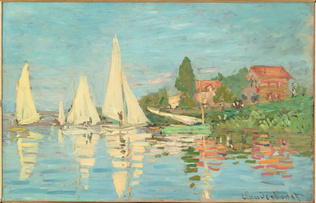
Boating became fashionable from 1830 in the Ile de France region. Racing boats competed at Argenteuil from 1850 because the Seine widened out into a basin which provided the broadest stretch of water in the Paris region. Linked to Paris by train, Argenteuil attracted many competitors and on Sundays crowds of people came to stroll by the river and watch the races. Claude Monet lived and worked at Argenteuil from December 1871 to 1878 and half of the 170 canvases he painted during this period show the banks of the Seine. Two years before the Impressionist movement officially came into existence, Monet painted this scene which has all its features, in particular the famous fragmented brushstroke. Regattas at Argenteuil was painted in natural light, because tin tubes and portable easels allowed artists to leave their studios and paint outside. Monet sought to capture the fluidity of air and water and the way they changed with the light. He explained what he was trying to do: "I want to do something intangible. It's appalling, this light that drifts off and takes the colour with it".
Object details
History - provenance, exhibitions, about this object record.
- de 1876 à 1894, dans la collection Gustave Caillebotte (sans doute acquis de l'artiste le 16 avril)
- 1894, accepté par l'Etat à titre de legs de Gustave Caillebotte aux Musées nationaux
- de 1896 à 1929, musée du Luxembourg, Paris (entrée le 23 mars 1896, sortie le 30 janvier 1929)
- 1929, attribué au musée du Louvre, Paris
- de 1929 à 1947, musée du Louvre, Paris
- de 1947 à 1986, musée du Louvre, galerie du Jeu de Paume, Paris
- 1986, affecté au musée d'Orsay, Paris
- Exposition des Sociétés d'Art françaises - Palacio de Bellas Artes - Espagne, Barcelone, 1917, n°807
- Art français - musée d'Art et d'Histoire - Suisse, Genève, 1918, n°103
- International Society - organisme inconnu - Royaume-Uni, Londres, 1925
- Claude Monet - galerie Thannhauser - Allemagne, Berlin, 1928, n°21
- Claude Monet : exposition rétrospective - musée de l'Orangerie - France, Paris, 1931
- Biennale di Venezia - organisme inconnu - Italie, Venise, 1932, n°34
- La peinture française au XIXe siècle - musée national - Serbie, Belgrade, 1939
- Exposition du centenaire Monet-Rodin - musée de l'Orangerie - France, Paris, 1940
- Monet - galerie Wildenstein - France, Paris, 1952, n°26
- Claude Monet 1840-1926 - Kunsthaus Zürich - Suisse, Zurich, 1952
- Claude Monet - Gemeentemuseum - Pays-Bas, La Haye, 1952
- Chefs-d'oeuvre impressionistes - musée de l'Orangerie - France, Paris, 1956
- Un século de pintura francesa 1850-1950 [Un siècle de peinture française 1850-1950] - fondation Calouste Gulbenkian - Portugal, Lisbonne, 1965, n°100
- Centenaire de l'Impressionnisme - Galeries nationales du Grand Palais - France, Paris, 1974
- Centenaire de l'Impressionnisme - Metropolitan Museum of Art - Etats-Unis, New York, 1974-1975
- Hommage à Claude Monet - Galeries nationales du Grand Palais - France, Paris, 1980
- Impressionists on the Seine. A celebration of Renoir's Luncheon of the Boating Party - The Phillips Collection - 1996-1997
- Monet la Senna le ninfee. Il grande fiume e il nuovo secolo - Museo della città - Italie, Brescia, 2004-2005
- Monet. L'art de Monet et sa postérité - National Art Center - Japon, Tokyo, 2007, n° 43
- Claude Monet 1840-1926 - Galeries nationales du Grand Palais - France, Paris, 2010-2011
- Impressionismo. Paris e a modernidade. Obras-primas Musée d'Orsay - Centro Cultural Banco do Brasil - Brésil, Săo Paulo, 2012
- Impressionismo. Paris e a modernidade. Obras-primas Musée d'Orsay - Centro cultural Banco do Brasil - Brésil, Rio de Janeiro, 2012-2013
- Eblouissants reflets. Cents chefs-d'oeuvres impressionnistes - musée des Beaux-Arts - France, Rouen, 2013
- La couleur réfléchie. L'impressionnisme à la surface de l'eau - musée des Beaux-Arts - France, Rouen, 2013
- Naissance de l'impressionnisme - National Art Center - Japon, Tokyo, 2014
- Monet - Galleria Civica d'Arte Moderna e Contemporanea - Italie, Turin, 2015-2016
- Monet: The Early Years - Kimbell Art Museum - Etats-Unis, Fort Worth, 2016-2017
- Monet: The Early Years - Legion of Honor - Etats-Unis, San Francisco, 2017
- Impressionnisme : quelle modernité ? - Louvre Abu Dhabi - Emirats Arabes Unis, Abu Dhabi, 2022-2023
- Bazin, Germain ; Adhémar, Hélène ; Sérullaz, Maurice, Catalogue des peintures, pastels, sculptures impressionnistes , Paris, Réunion des musées nationaux, 1958, n°234, p.126, non reprod.
- Adhémar, Hélène ; Dayez-Distel, Anne, Musée du Jeu de Paume - Catalogue rédigé , Paris, Editions des musées nationaux, 1977, p.156, reprod. p.66 et coul. p.71 (détail)
- Rossi Bortolatto, Luigina ; Bailly-Herzberg, Janine, Tout l'oeuvre peint de Monet. 1870-1899 , Paris, Flammarion, 1981, n°73, p.92, reprod. p.92 et pl.IIB
- Patin, Sylvie, Monet , Paris, Musée d'Orsay ; Skira ; Flammarion, 2011, p.8-9, reprod. p.9 (détail) et p.33
- Huisman, Georges (pref), La peinture française au XIXe siècle, cat. exp. (Belgrade, musée national, du 28 février au 04 mai 1939) , Paris, Association française d’action artistique, 1939, Notice 82
- Exposition du centenaire MONET-RODIN : au profit de l'entr'aide des artistes, cat. exp. (Paris, musée de l'Orangerie, 1940) , Paris, [s.n.], 1940, n° 48
- Monet, cat. exp. (La Haye, Geweentemuseum Van's-Gravenhage, juillet-septembre 1952) , La Haye, [s.n.], 1952, n° 27
- Besson, Georges, Claude Monet 1840-1926, cat. exp. (Zurich, Kunsthaus, du 10 mai au 15 juin 1952) , Zurich, Kunsthaus Zurich, 1952, n° 26
- Daulte, François ; Tominaga, Soichi, Le Centenaire de l'Impressionnisme, cat.exp. (Paris, Grand palais, du 21 septembre au 24 novembre 1974) , Vino, Yomiuri Shimbun, 1974, n° 29
- Rathbone, Eliza E. ; Rothkopf, Katherine ; Brettell, Richard R., Impresionists on the Seine : a Celebration of Renoir’s Luncheon of the Baoating Party, cat. exp. (Washington, The Phillips Collection, 1996-1997) , Washington, Counterpoint, 1996, n° 12
- Goldin, Marco (dir.), Monet. La Senna. Le Ninfee. Il grande fiume e il nuovo secolo, cat. exp. (Brescia, Museo di Santa Giulia, 23 octobre 2004-20 mars 2005) , Conegliano, Linea d'ombra libri, 2004, n° 81
- Patin, Sylvie ; Patry, Sylvie ; Roquebert, Anne ; Thomson, Richard, Monet, cat.exp. (Paris, Galeries nationales, Grand Palais, Paris, 22 septembre 2010-24 janvier 2011) , Paris, Réunion des musées nationaux ; Musée d'Orsay, 2010, n° 34, p. 135
- Cogeval, Guy (dir.), Mathieu, Caroline (dir.), Jiménez, Burillo (dir), Cahn, Isabelle, Impressionismo. Paris e a modernidade : obras-primas, Musée d'Orsay, cat. exp. (Sao Paulo, 4 août-7 octobre 2012 ; Rio de Janeiro, 22 octobre 2012-13 janvier 2013 ; Madrid, 12 février-5 mai 2013) , São Paulo / Madrid, Expomus / Fundación Mapfre, 2012, n° 53, p. 265 ; p. 165 (reprod.)
- Amic, Sylvain ; Chardin, V. ; Nonne, M. ; David-Frank, J.-M. ; Eybert, M., Eblouissants reflets : cent chefs-d'oeuvre impressionnistes, cat. exp. (Rouen, musée des beaux-arts, du 29 avril au 30 septrembre 2013) , Rouen / Paris, musées de la Ville de Rouen / Réunion des musées nationaux, 2013, n° 58
- Cogeval, Guy ; Rey, Xavier ; Bertone, Virginia ; Perrin, Paul ; Patin, Sylvie ; Badie Modiri, Elsa, Monet. Dalle collezioni del Musée d’Orsay, cat. exp. (Turin, Galleria Civica d’Arte Moderna et Contemporeana, 02 octobre 2015 au 31 janvier 2016) , Paris, Skira, 2015, cat. 11, pp. 114-115 (reprod. coul.) ; p. 32 ; p. 35 ; p. 37 ; p. 111 ; p. 113
- Kisiel, Marine ; Perrin, Paul, Colours of Impressionism, Masterpieces from the Musée d'Orsay, cat. exp. (Singapore, The National Gallery, 16 nov. 2017-11 mars 2018) , Singapore, National Library Board, 2018, Fig. 21, pp.103-104, repr. p.104
- Wildenstein, Daniel, Claude Monet : catalogue raisonné Claude Monet. 1, 1840-1881, peintures , Paris, Bibliothèque des Arts ; Wildenstein institute, 1974, n°233
- Compin, Isabelle ; Roquebert, Anne, Catalogue sommaire illustré des peintures du Musée du Louvre et du Musée d'Orsay , Paris, Réunion des musées nationaux, 1986, vol.4, p.104
- Compin, Isabelle [coordination] ; Lacambre, Geneviève [coordination] ; Roquebert, Anne, Musée d'Orsay. Catalogue sommaire illustré des peintures , Paris, Réunion des musées nationaux, 1990, vol.2, p.332
Do you have a question where you have additional knowledge about this work? You can write to us to suggest improvements to the file.
Other artworks from artist

Claude Monet, Saule pleureur
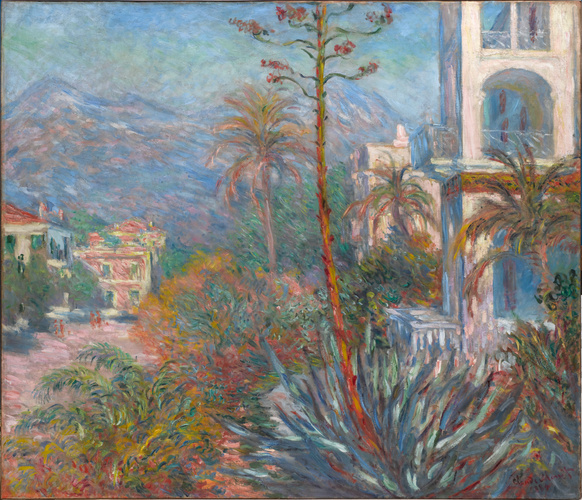
Claude Monet, Les Villas à Bordighera
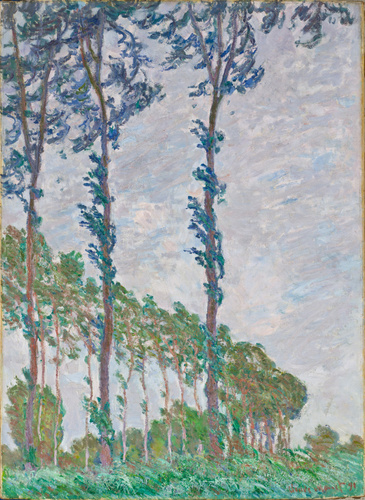
Claude Monet, Effet de vent, série des peupliers

Claude Monet, La Gare Saint-Lazare

Claude Monet, Le Déjeuner sur l'herbe
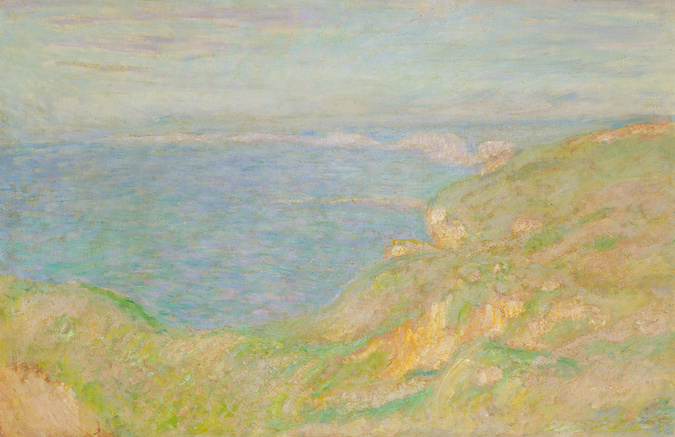
Claude Monet, Falaise de Fécamp
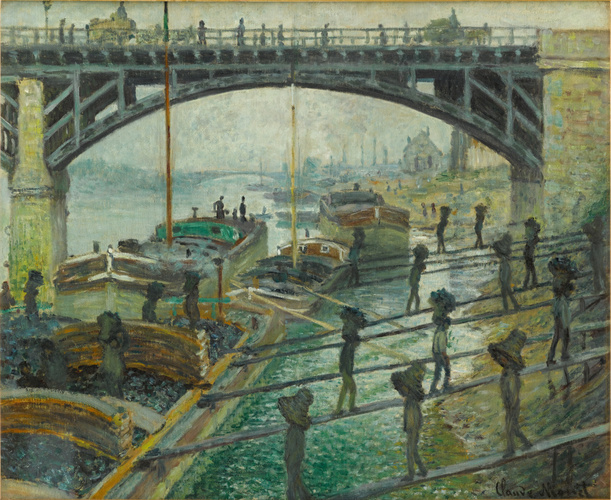
Claude Monet, Les Déchargeurs de charbon
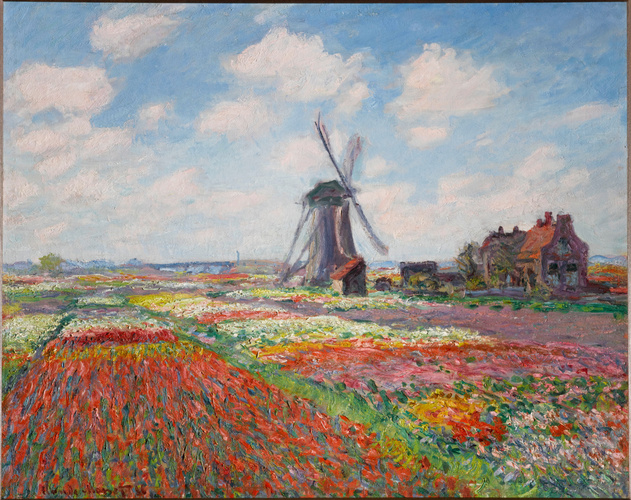
Claude Monet, Champs de tulipes en Hollande
Search FAMSF
Mobile navigation, social sharing.
- Copy Page URL Copied to clipboard!
Sailboats on the Seine at Petit-Gennevilliers
Claude Monet
Artwork Viewer
Exhibition history, bibliography, currently on view, woman holding a swan, mid 4th century bc, composition of right foot, 19th-20th century, a mature man preparing to make love to a young girl, ninth scene from the series handscroll for the sleeve (sode no maki), ca. 1780-1790, new acquisitions, the little eugène de montesquiou-fézensac asleep, 1783, motif pour tenue de reine, 2023, woman's ensemble: dress (a) and bracelet (b), ca. 1920, portrait of bianca degli utili maselli and her children, ca. 1604-5, portrait of a youth through time, 2022.
Your Collection
Log in to the harvard art museums, 1951.54: red boats, argenteuil.
- Add to Collection
- copy = 'Copy Permanent URL', 2000)" data-behavior="tooltip"> Copy Link
- Reuse via IIIF
- $focus.focus($refs.osd_viewer), 250)};" x-tooltip.raw="Toggle Deep Zoom Mode" data-behavior="tooltip" target="_blank" > Toggle Deep Zoom Mode
Gallery Text
For most of the 1870s, Monet lived in Argenteuil, a town on the Seine only seventeen miles from Paris and accessible to the city by train. He often worked outdoors in his own boat and painted this basin several times, though the lower vantage point of this scene suggests a perspective from the shoreline. Eliminating the factory smokestacks that were in fact visible at this location, Monet instead highlights the area’s picturesque and recreational aspects, including the boat rental area on the left.
Impressionist painters like Monet deliberately eschewed the finished structure and line of academic painting, but the irresolution of this painting has led to its occasional categorization as a “study.” As revealed in x-radiographs, the artist reworked the composition in several areas, removing a sixth paddling duck on the left, for example, by painting over it. The band of lavender brushstrokes along the horizon line is the site of a similar revision.
Identification and Creation
Physical descriptions.
- Signed: l.l. Claude Monet 75
Acquisition and Rights
THIS WORK HAS SIGNIFICANT LOAN RESTRICTIONS BY THE TERMS OF ITS ACQUISITION TO THE HARVARD ART MUSEUMS.
The Harvard Art Museums encourage the use of images found on this website for personal, noncommercial use, including educational and scholarly purposes. To request a higher resolution file of this image, please submit an online request.
Publication History
- 2e Exposition de peinture , exh. cat., Galerie Durand-Ruel (Paris, France, 1876), no. 160
- Monet-Rodin , exh. cat., Galerie Georges Petit (Paris, France, 1889), no. 27
- Arsène Alexandre, "La Collection E. L.", La Renaissance (October 1933 - November 1933), vol. XVI, pp. 182, 193
- Alfred M. Frankfurter, "Today's Collectors: Modern Milestones", Art News (June 1946), vol. XLV, no. 4, p. 64
- French Painting since 1870, lent by Maurice Wertheim, Class of 1906 , exh. cat., Fogg Art Museum (Cambridge, MA, 1946), p. 10, repr. p. 11
- John Rewald, The History of Impressionism [1st ed.] , The Museum of Modern Art (New York, NY, 1946), p. 347, repr. p. 285
- Oscar Reuterswärd, Monet, en konstnarshistorik , Albert Bonniers Förlag (Stockholm, Sweden, 1948), p. 282
- La Peinture Française Depuis 1870: Collection Maurice Wertheim , exh. cat., Tom Taylor (Québec, Canada, 1949), no. 3, pp. 9-10
- A Collector's Exhibition: Impressionist and Post-Impressionist Masterpieces from the Collections of Members of the Advisory Committee of the Institute of Fine Arts. , exh. cat., Knoedler & Co. Inc. (New York, NY, 1950), no. 4
- Howard Devree, "By French Masters: The Metropolitan Shows Wertheim Collection", The New York Times (New York, NY, July 6 1952), p. 6, p. 6
- John Canaday, Mainstreams of Modern Art , Henry Holt and Co. (New York, NY, 1959), repr. p. 96
- The Maurice Wertheim Catalogue: Modern French Art-- Monet to Picasso , exh. cat., North Carolina Museum of Art (Raleigh, NC, 1960), p. 28, repr. p. 28
- The Maurice Wertheim Collection: Manet to Picasso , exh. cat., The Museum of Fine Arts, Houston (Houston, TX, 1962), p. 32, pl. 11
- L'Opera completa di Claude Monet, 1870-1889 , Rizzoli (Milan, Italy, 1972), p. 97; repr. p. 96
- The Maurice Wertheim Collection , exh. cat., Maine State Museum (Augusta, ME, 1972), no. 20
- Daniel Wildenstein, Claude Monet: Biographie et Catalogue Raisonné , La Bibliothèque des Arts (Lausanne, Switzerland, 1974 - 1991), no. 369
- Robert L. Herbert, "Method and Meaning in Monet", Art In America (September 1979), vol. 67, pp. 90-108, p. 108
- Paul Hayes Tucker, Monet at Argenteuil , Yale University Press (New Haven, CT and London, England, 1982), pl. XX, pp. 118-120, 149
- Kristin A. Mortimer and William G. Klingelhofer, Harvard University Art Museums: A Guide to the Collections , Harvard University Art Museums and Abbeville Press (Cambridge and New York, 1986), no. 219, p. 192, repr. in color
- Helen Langdon, Impressionist Seasons , Phaidon Press (Oxford, England, 1986), repr. in color no. 11, p. 37; text p. 36
- John House, Monet: Nature into Art , Yale University Press (New Haven, CT and London, England, 1986), pl. 20, pp. 18, 83
- Bernard Denvir, The Impressionists at First Hand , Thames & Hudson (London, England, 1987), repr. in b/w, p. 81
- John O'Brian, Degas to Matisse: the Maurice Wertheim Collection , Harry N. Abrams, Inc. and Fogg Art Museum (New York, NY and Cambridge, MA, 1988), no. 4, p. 45-47, repr. in color p. 46
- Edgar Peters Bowron, European Paintings Before 1900 in the Fogg Art Museum: A Summary Catalogue including Paintings in the Busch-Reisinger Museum , Harvard University Art Museums (Cambridge, MA, 1990), p. 120; repr. as no. 348
- The Maurice Wertheim Collection and Selected Impressionist and Post-Impressionist Paintings and Drawings in the Fogg Art Museum , exh. cat., Harry N. Abrams, Inc. (New York, NY, 1990), repr. in color no. 5, p. 41
- Richard Mühlberger, O Que Faz de um Monet um Monet? , The Metropolitan Museum of Art (New York, 1993), pp. 48-49, repr. in color with detail
- Richard Mühlberger, What Makes a Monet a Monet? , Metropolitan Museum of Art / Viking (New York, NY, 1993), repr. in color inside back cover and details, p. 48
- Lawrence S. Cunningham and John J. Reich, Culture and Values: A Survey of the Western Humanities , Harcourt Brace College Publishers (New York, NY, 1994), pp. 365-366, repr. in color fig 16.7
- Lynn Federle Orr, Monet: Late Paintings of Givenchy from the Musée Marmottan , exh. cat., Fine Arts Museums of San Francisco (San Francisco, CA, 1994), p. 18, repr. in color fig. 4
- H. W. Janson and Anthony F. Janson, History of Art [5th ed.] , Harry N. Abrams, Inc. (New York, NY, 1995), pp. 705-706, repr. in color, fig. 949
- H. W. Janson and Anthony F. Janson, History of Art for Young People , Harry N. Abrams, Inc. (New York, NY, 1997), p. 462, fig. 396
- Christie's Impressionist and Nineteenth Century Art , auct. cat., Christie's, New York (New York NY, November 18 1998), under no. 13, repr. in color as fig. 3
- Norio Shimada and Keiko Sakagami, Claude Monet 1881-1926 , exh. cat., Toppan Tanc (Japan, 2001), p. 92, fig. 66, repr. in color
- Lawrence S. Cunningham and John J. Reich, Culture & Values: A Survey of the Humanities , Thomson Wadsworth (Belmont, CA, 2006), pp. 491-492, repr. in color as fig.18.7
- Elizabeth M. Rudy, "Researching the Wertheim Collection at the Harvard Art Museums", Collections: A Journal for Museum and Archives Professionals (Summer 2014), Vol. 10, No. 3, pp. 301-6, p. 303
- Camran Mani and Cecilia Zhou, ed., A Collection of Perspectives: Ho Family Student Guides at the Harvard Art Museums , Harvard Art Museums (Cambridge, 2023), pp. 14-15, repr. p. 15
Exhibition History
- Deuxieme exposition de peinture , Rue le Peletier, Paris, 04/01/1876 - 04/30/1876
- Monet-Rodin , Galerie Georges Petit, Paris, 01/01/1889 - 12/31/1889
- French Painting since 1870 lent by Maurice Wertheim, Class of 1906 , Fogg Art Museum, Cambridge, 06/01/1946 - 09/07/1946; National Gallery of Art, Washington, 07/01/1953 - 09/13/1953
- La Peinture Française depuis 1870 , Musée de la Province de Quebec, 07/12/1949 - 08/07/1949
- A Collector's Exhibition , M. Knoedler & Co., Newport, 02/06/1950 - 02/25/1950
- The Maurice Wertheim Collection , The Metropolitan Museum of Art, New York, 07/01/1952 - 09/14/1952
- French Paintings Since 1870 from the Maurice Wertheim Collection , National Gallery of Art, Washington, 06/01/1953 - 09/30/1953
- The Maurice Wertheim Collection , Philadelphia Museum of Art, Philadelphia, 06/15/1957 - 09/15/1957
- The Maurice Wertheim Collection , Minneapolis Institute of Arts, Minneapolis, 06/10/1958 - 08/31/1958
- The Maurice Wertheim Collection: Modern French Art--Monet to Picasso , North Carolina Museum of Art, Raleigh, 06/17/1960 - 09/04/1960
- The Maurice Wertheim Collection: Manet to Picasso , The Museum of Fine Arts, Houston, Houston, 06/13/1962 - 09/02/1962
- The Maurice Wertheim Collection , Baltimore Museum of Art, Baltimore, 06/20/1963 - 09/01/1963
- The Maurice Wertheim Collection , Currier Museum of Art, Manchester, 06/24/1965 - 09/07/1965
- The Maurice Wertheim Collection , Rhode Island School of Design Museum, Providence, 09/03/1968 - 09/22/1968
- The Maurice Wertheim Collection , Montgomery Museum of Art, Montgomery, 06/01/1971 - 09/30/1971
- The Maurice Wertheim Collection , Maine State Museum, Augusta, 06/01/1972 - 09/01/1972
- Manet to Matisse: The Maurice Wertheim Collection , IBM Gallery of Science and Art, New York, 04/09/1985 - 05/25/1985
- The Maurice Wertheim Collection and Selected Impressionist and Post-Impressionist Paintings and Drawings in the Fogg Art Museum , Isetan Department Store, Tokyo, 03/01/1990 - 04/10/1990; Yamaguchi Prefectural Museum of Art, 04/14/1990 - 05/13/1990
- Re-View: S427 Impressionist & Postimpressionist Art , Harvard Art Museums/Arthur M. Sackler Museum, Cambridge, 08/02/2008 - 06/18/2011
- 32Q: 1220 Wertheim , Harvard Art Museums, Cambridge, 11/16/2014 - 01/01/2050
Subjects and Contexts
- Google Art Project
Related Articles

My Favorite Object: Michael Kirchner
Related works.
Artist of original: Claude Monet
X-radiograph(s) of "red boats at argenteuil", verification level.
This record has been reviewed by the curatorial staff but may be incomplete. Our records are frequently revised and enhanced. For more information please contact the Division of European and American Art at [email protected]
Where next?
Explore related content
Sailboats on the Seine at Petit - Gennevilliers
Claude monet 1874, legion of honor san francisco, ca, united states.
- Title: Sailboats on the Seine at Petit - Gennevilliers
- Creator: Claude Monet
- Date Created: 1874
- Physical Dimensions: 21 1/4 x 25 3/4 in. (54 x 65.4 cm)
- Rights: Gift of Bruno and Sadie Adriani
- Medium: Oil on canvas
Get the app
Explore museums and play with Art Transfer, Pocket Galleries, Art Selfie, and more


- Claude Monet
- Impression Sunrise
- Water Lilies
- Japanese Bridge
- Blooming Poppy Field
- Rouen Cathedral
- Woman with Parasol
- Houses of Parliament
- Sunset In Venice
- Full Screen Slider
Cliffs and Sailboats at Pourville
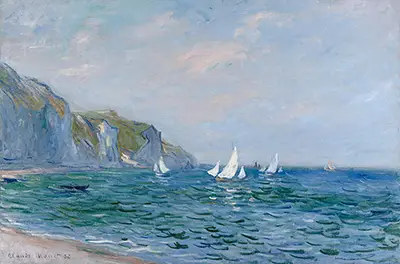
* As an Amazon Associate, and partner with Google Adsense and Ezoic, I earn from qualifying purchases.
Coastal landscapes and boats featured in paintings throughout Claude Monet’s career, the earliest of these being the Boatyard near Honfleur in 1864. However, the paintings that he produced around Pourville, including the oil on canvas Cliffs and Sailboats at Pourville, appear to have had a special significance to the artist.
In 1882, from February until mid-April, Monet stayed in Pourville. Enchanted by the beautiful countryside and ‘delightful nooks and crannies’, Monet returned in the summer; this time he was accompanied by Alice Hoschedé, who went on to become his wife in 1892. In addition to Cliffs and Sailboats at Pourville, the artist produced a further seven works in 1882 capturing different aspects of this area, including: Path Through the Corn at Pourville , Beach at Pourville Sunset and Cliff Walk at Pourville .
Initially, Claude Monet’s Cliffs and Sailboats at Pourville, draws the eye into the central cluster of boats, with their brilliant white sails gleaming in the sunlight; a few perfectly placed brush strokes, effortlessly hint at the reflections of these simple crafts.
On viewing the surface of the water more closely, silhouettes of more sailboats and even a small rowing boat begin to emerge, sheltering in the shadows of the cliffs. The highlights on the waves give the sense of a bright spring or summer’s day; whilst the darker areas suggest both the changing depth of the water, and the imposing cliffs.
Looking to the beautiful blue sky, small white clouds appear to be swept across the landscape towards the right of the painting. Monet continues to immerse us in the feeling of a breezy day through the billowing sails, which catch the wind and usher the boats in the same direction as the clouds.
This is further amplified by the tilted masts and way that the bows of the sailboats appear to lift out of the water. Visible flicks of the brush depict the ripples of a slightly choppy sea that the crafts must traverse.
In contrast to the soft sky above and delicate beach beneath, Monet’s cliffs are angular and abrupt in their nature; thin, defined lines separating the edge of the vegetation from the stone are a stark contrast to the other techniques used in this artwork. Graduated slopes of greenery are followed by sharp drops and cliff edges which jut out towards the sea.
A flash of light and hint of rose among these rocks suggest a cove, only visible when the sun is in the right position. The open composition of the pastel pink beach, cliffs and sea allow the viewer to imagine what might lie beyond, and ponder where these sailboats are destined.
Claude Monet (1840–1926) was a French painter, whose work led to the late 19th-century Impressionist art movement . A radical change from the Realism that dominated in France following the 1848 Revolution, the artist’s work focused on accurate depiction of light and delivering a sense of movement.
Despite the harsh criticism that Monet endured from the conventional art community in France at the time, he still viewed his greatest achievement as having ‘painted directly in front of nature, seeking to render my impressions of the most fleeting effects'.
Hi, I'm Tom!

I'm the writer and founder of MonetPaintings.org. I have studied different art movements for over 15 years, and am also an amateur artist myself! Read my bio here.


Red Boats at Argenteuil, 1875 by Claude Monet
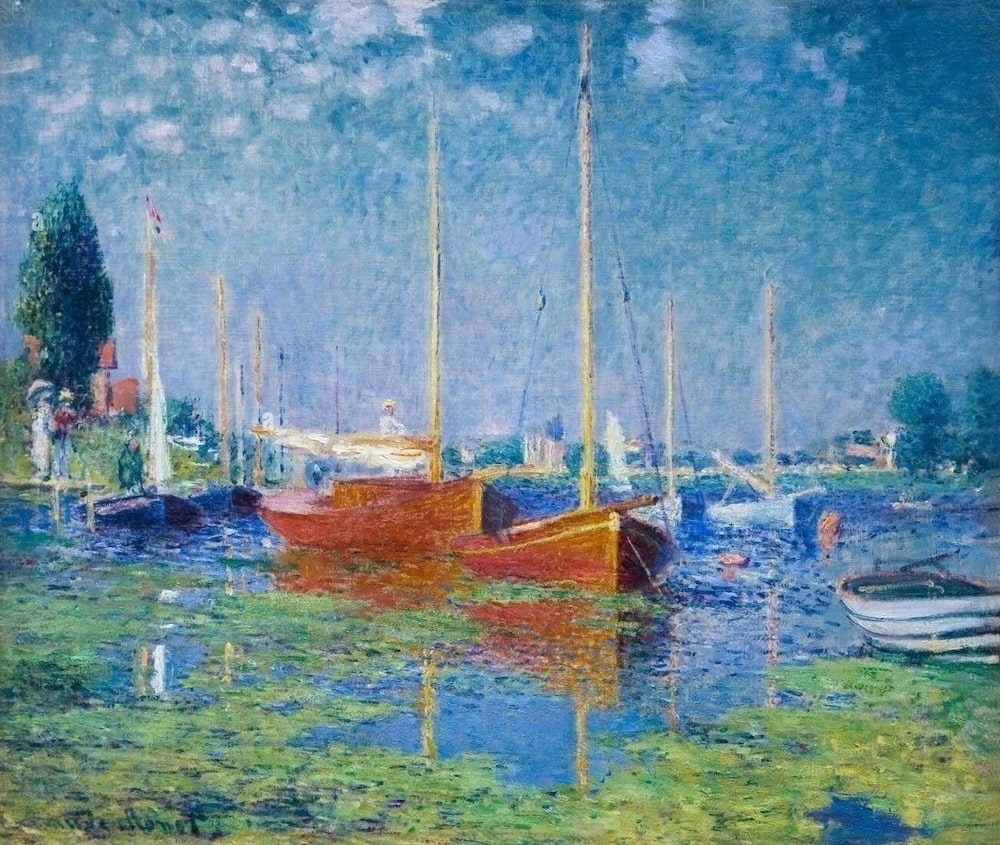
Monet painted the town and surrounding area of Argenteuil through the 1870s and in each instant created pictures of beauty and harmony, which were often at odds with the reality of the moment. Although an adherent of en plein air painting, Monet carefully chose the elements he wanted to include and often finished his canvases in the studio.
There is no hint in his paintings of the pollution in the river at Argenteuil or the disarray of a town throwing everything into its industry. In Red Boats at Argenteuil ,1875, Monet has constructed the composition through the use of the boats, especially in the verticals of the masts Here again he uses contrasting colours through his blues and orange and reds and greens.
The canvas is alive with colour, while the depth of the water is illustrated through the purples and blues. The brushstrokes ore uniform through the water in their choppy style, but the sky is more broadly painted with blurring and merging colours, creating a very distinct contrast between the depth of the water and the translucence of the sky.
Impression Sunrise
San giorgio maggiore at dusk, water lilies, the artist's garden at giverny, the poppy field near argenteuil, the waterlily pond, the garden of monet at argenteuil, poppy field, tulip fields, women in the garden, cliff walk at pourville, the garden at sainte-adresse, garden path at giverny, waterloo bridge, water lilies: morning, rouen cathedral, woman with a parasol.

IMAGES
COMMENTS
Sailboats, regatta at Argenteuil, 1874 Claude Monet (1840-1926) Courtesy of Wikimedia Commons. Monet used the same pale palette for the sky, the sailboats and the river, adding tints of red for the houses to break the uniformity. Sky and water are dappled, and the boats are appear bunched together as they move gracefully along the river.
2 Top 11 Most Famous Seascape Paintings by Claude Monet. 2.1 The Seine Estuary at Honfleur (1865) 2.2 The Port of Sainte-Adresse (1867) 2.3 Garden at Sainte-Adresse ... providing a peaceful backdrop for the resting boats. Monet's careful attention to detail in depicting the sea's surface reflects his keen observation of light and its ...
Forced indoors by inclement fall weather, Claude Monet painted Boats on the Beach at Étretat and The Departure of the Boats, Étretat while looking out the window of his room at the Hôtel Blanquet. The two form a pair that share a palette, subject, and vantage point. In one of his daily letters to his companion and future wife, Alice Hoschedé, dated November 24, 1885, Monet he described ...
Media in category "Paintings of boats by Claude Monet". The following 200 files are in this category, out of 236 total. (previous page) ( next page) 'Canal à Zaandam' by Claude Monet, 1871.JPG 2,935 × 1,560; 719 KB. 'Le Havre, Bâteaux de Peche Sortant du Port' by Claude Monet, 1874.JPG 3,464 × 1,900; 707 KB. 'The Grand Quay at Havre' by ...
The Beach at Sainte-Adresse. 1867. Claude Monet (French, 1840-1926) In the summer of 1867 Claude Monet stayed with his aunt in Sainte-Adresse, an affluent suburb of the port city of Le Havre in Normandy, where the artist grew up. Monet began the painting outdoors on an overcast day but likely revised the composition in his studio in view of ...
Famous Claude Monet Paintings; Claude Monet Quoets; Regattas at Argenteuil, 1872 by Claude Monet. Regattas at Argenteuil, 1872 by Claude Monet. More than 40 years after boating became fashionable, Monet took great care with his depictions of boats of all descriptions. Here, he carefully crafts racing boats on the Seine - they competed at ...
Cliffs and Sailboats at Pourville (1882) seem to lack some of the obvious spontaneity evident in other paintings by Claude Monet, although the scurrying clouds in the former have some sense of being captured on canvas on location. The painting depicts sailing boats, which had already proved a popular subject when Monet lived at Argenteuil.
Bequeathed, 1924. Number. NGI.852. From 1871 to 1878, Monet lived in Argenteuil on the outskirts of Paris. During this period, he fitted out a boat as a floating studio and painted many views of the River Seine and its banks. He made this picture in 1874, the year that the first Impressionist exhibition was held in Paris.
Title: Sailboats on the Seine at Petit - Gennevilliers. Creator: Claude Monet. Date Created: 1874. Physical Dimensions: 21 1/4 x 25 3/4 in. (54 x 65.4 cm) Rights: Gift of Bruno and Sadie Adriani. Medium: Oil on canvas. Explore museums and play with Art Transfer, Pocket Galleries, Art Selfie, and more. Google Arts & Culture features content from ...
Racing boats competed at Argenteuil from 1850 because the Seine widened out into a basin which provided the broadest stretch of water in the Paris region. ... Claude Monet lived and worked at Argenteuil from December 1871 to 1878 and half of the 170 canvases he painted during this period show the banks of the Seine. ... Monet. L'art de Monet et ...
The Beach at Honfleur is an oil-on-canvas painting by French impressionist Claude Monet. The painting depicts a beach on the Côte de Grâce with sailboats, the hospital of Honfleur, and a lighthouse in the distance. In the foreground, a solitary figure in a blue smock stands on the beach. The painting was created with short, thick brushstrokes ...
Claude Monet Title Sailboats on the Seine at Petit-Gennevilliers Date 1874 Place of Creation Gennevilliers Object Type Painting Medium Oil on canvas ... Art Institute of Chicago, March 15-May 11, 1975. "Paintings by Monet," no. 37. Portland, Joan Whitney Payson Gallery of Art, May 7-November 1, 1987. Permanent collection loan.
The Studio Boat (Le Bateau-atelier) is a painting from 1876 by the French Impressionist Claude Monet.The work depicts Monet at work in his studio boat on the Seine in Argentueil. [1] It was executed en plein air in oil on canvas. It currently is in the collection of the Barnes Foundation of Philadelphia. [2]Monet bought the boat around 1873 soon after moving to Argenteuil.
In 1865, a young Monet submitted two large marine oil paintings to the official Paris Salon, and the acceptance of both marked the official beginning of his career. During the 1860s, while still in his twenties, Monet began developing a style that would eclipse that of his early mentors and painting companions.
Claude Monet's Sailboat seems to take viewers on a journey away from the stresses of life. The Impressionist painter has gained many fans for his portrayals of nature and the outdoors. His Sailboat painting does not fail to please. It is rich with the masterful use of colour that creates a pleasing scene of a boat, the sea and the warm sky.
Famous works. Inspired by a true story, Invincible recounts the last 48 hours in the life of Marc-Antoine Bernier, a 14-year-old boy on a desperate quest for freedom. 'The Boats Regatta at Argenteuil' was created in 1874 by Claude Monet in Impressionism style. Find more prominent pieces of landscape at Wikiart.org - best visual art database.
"Red Boats, Argenteuil (Claude Monet) , 1951.54," Harvard Art Museums collections online, Aug 23, 2024, https://hvrd.art/o/228650. Reuse via IIIF; ... Alternate Title: Red Boats II Classification Paintings Work Type painting Date 1875 Culture French Persistent Link https://hvrd.art/o/228650 Location
Famous works. Inspired by a true story, Invincible recounts the last 48 hours in the life of Marc-Antoine Bernier, a 14-year-old boy on a desperate quest for freedom. 'Boats in the Port of Honfleur' was created in 1866 by Claude Monet in Impressionism style. Find more prominent pieces of cityscape at Wikiart.org - best visual art database.
Title: Sailboats on the Seine at Petit - Gennevilliers. Creator: Claude Monet. Date Created: 1874. Physical Dimensions: 21 1/4 x 25 3/4 in. (54 x 65.4 cm) Rights: Gift of Bruno and Sadie Adriani. Medium: Oil on canvas. Explore museums and play with Art Transfer, Pocket Galleries, Art Selfie, and more. Google Arts & Culture features content from ...
Coastal landscapes and boats featured in paintings throughout Claude Monet's career, the earliest of these being the Boatyard near Honfleur in 1864. However, the paintings that he produced around Pourville, including the oil on canvas Cliffs and Sailboats at Pourville, appear to have had a special significance to the artist.
In Red Boats at Argenteuil ,1875, Monet has constructed the composition through the use of the boats, especially in the verticals of the masts Here again he uses contrasting colours through his blues and orange and reds and greens. The canvas is alive with colour, while the depth of the water is illustrated through the purples and blues.
Claude Monet. Famous works. Inspired by a true story, Invincible recounts the last 48 hours in the life of Marc-Antoine Bernier, a 14-year-old boy on a desperate quest for freedom. 'Sailboats' was created in 1866 by Claude Monet in Impressionism style. Find more prominent pieces of marina at Wikiart.org - best visual art database.
List of paintings created during 1858-1871 1872-1878 1878-1881 1881-1883 1884 1884-1888 1888 1888-1898 1899-1904 1900-1926 This is a list of works by Claude Monet (1840-1926), including all the extant finished paintings but excluding the Water Lilies, which can be found here, and preparatory black and white sketches. Monet was a founder of French impressionist painting, and ...